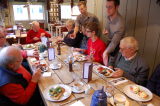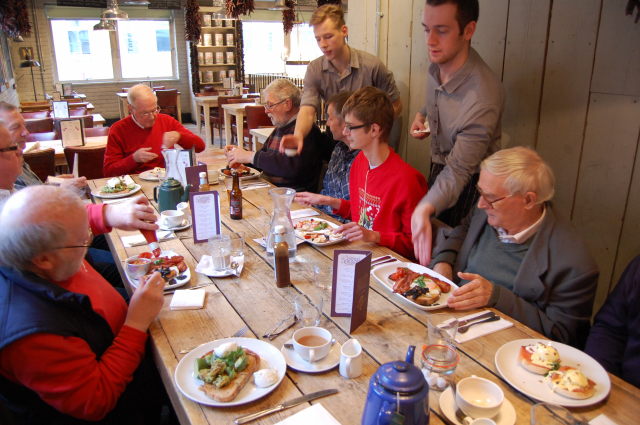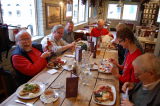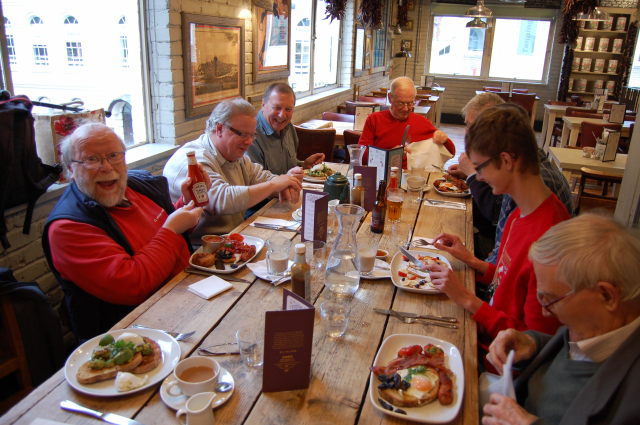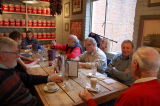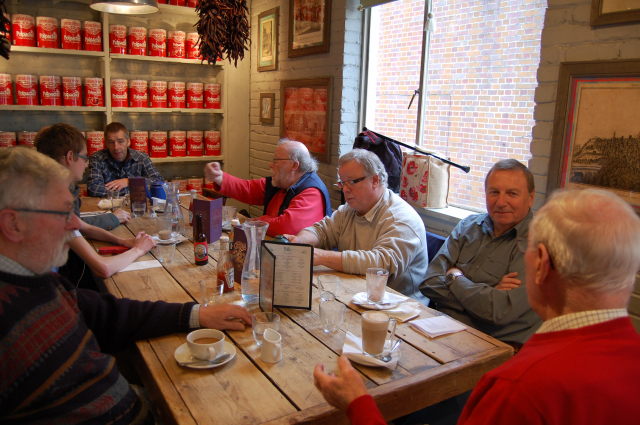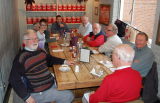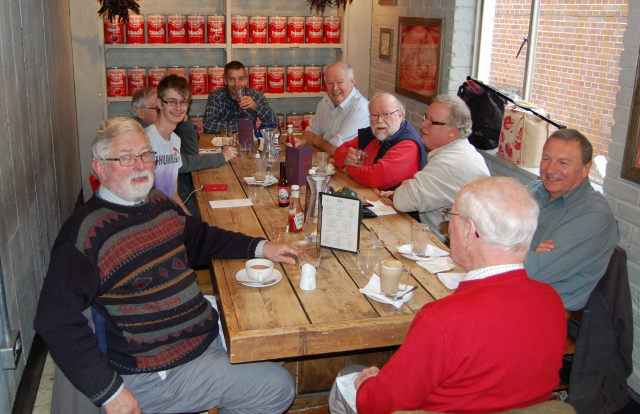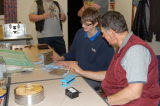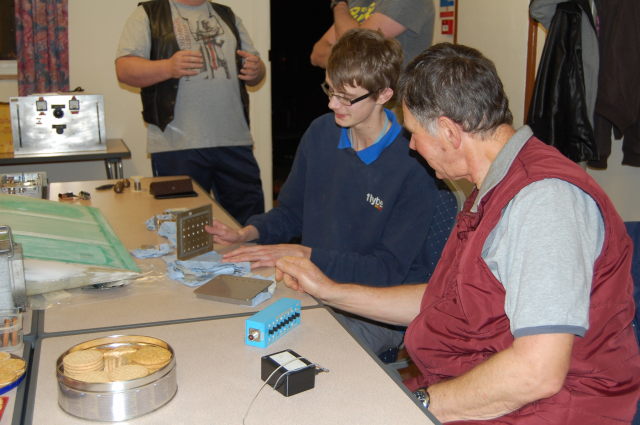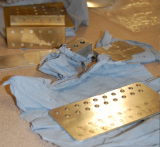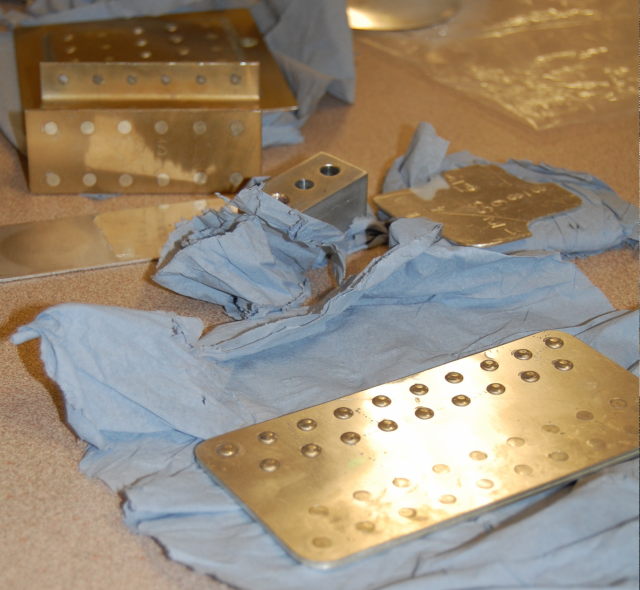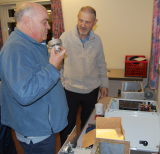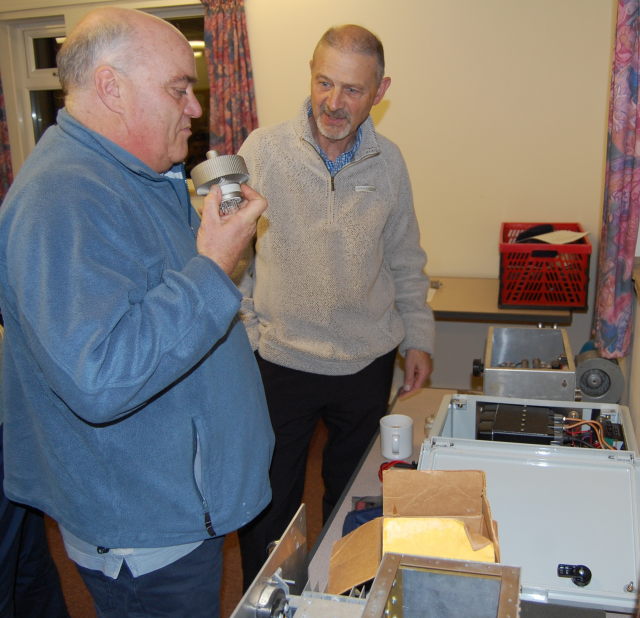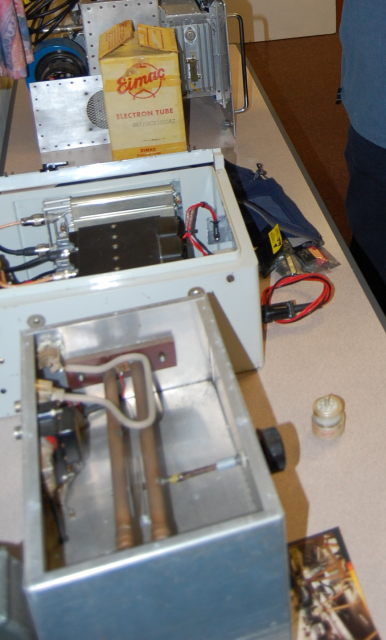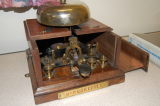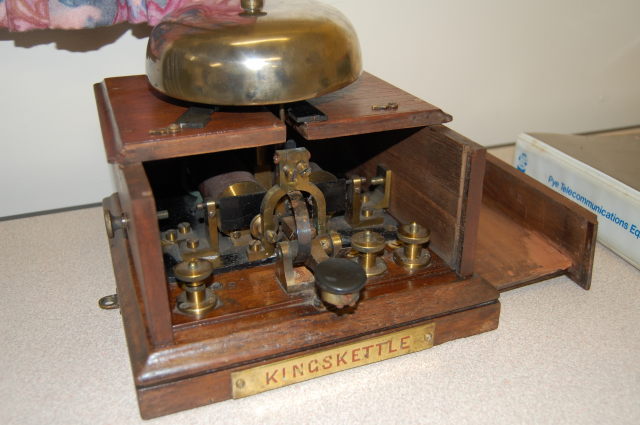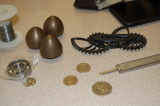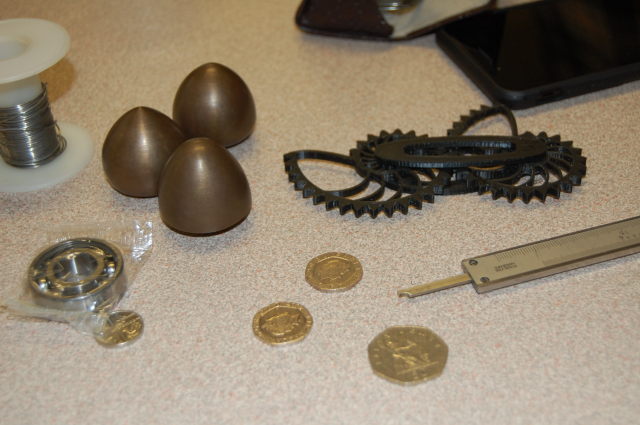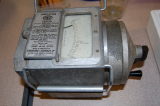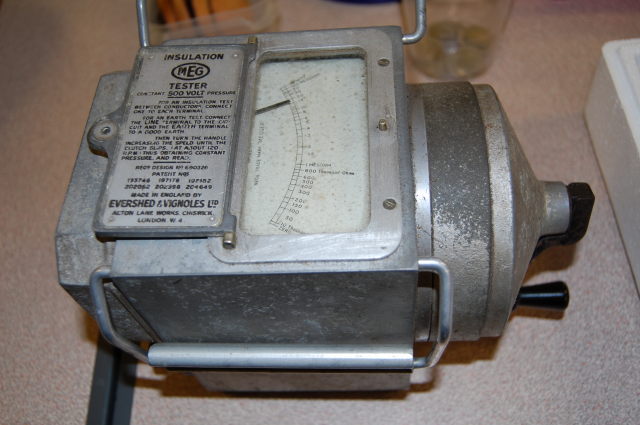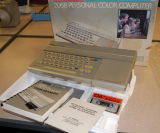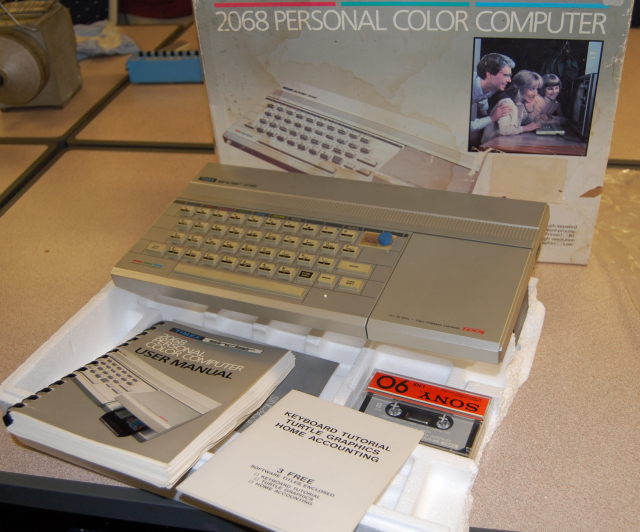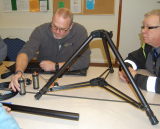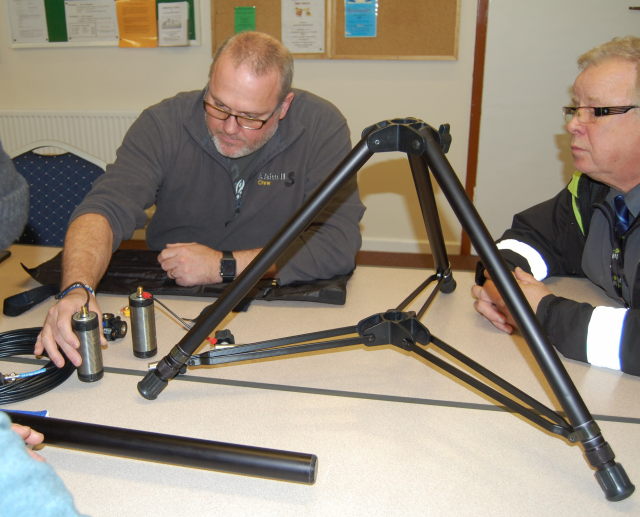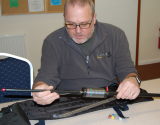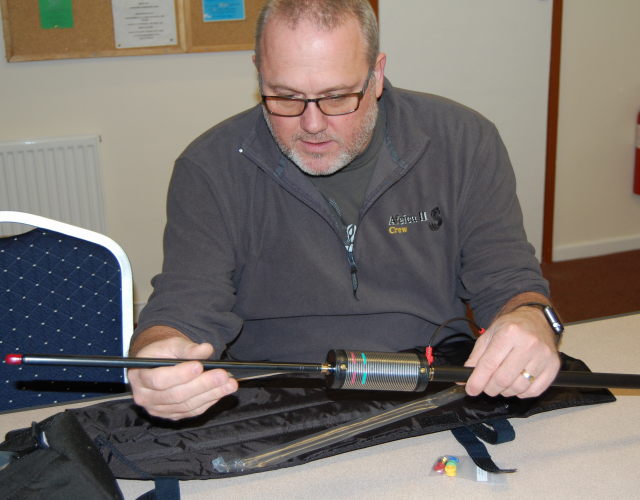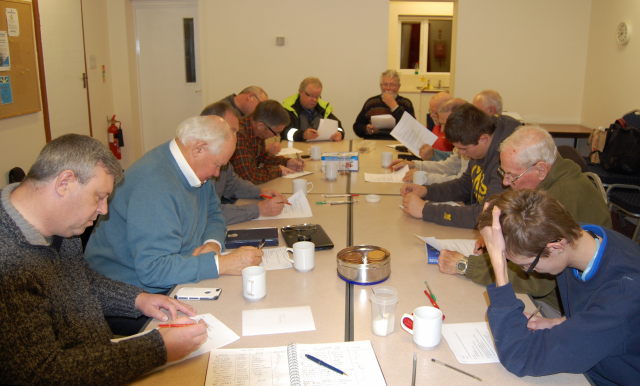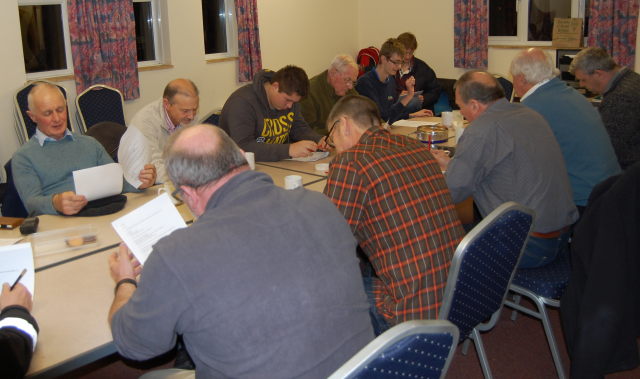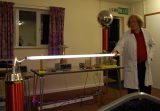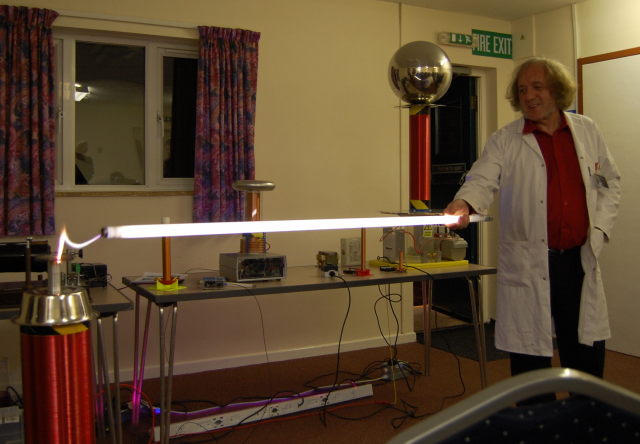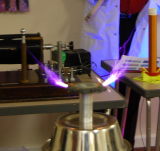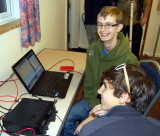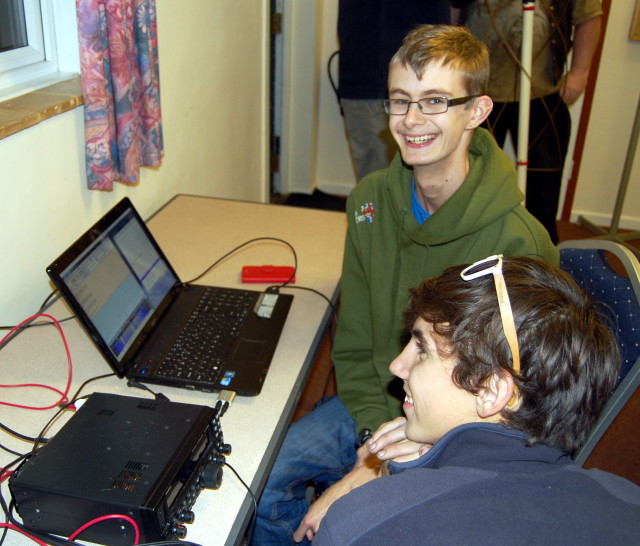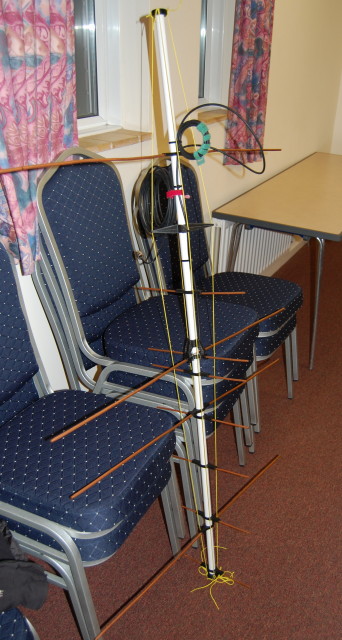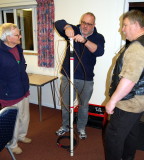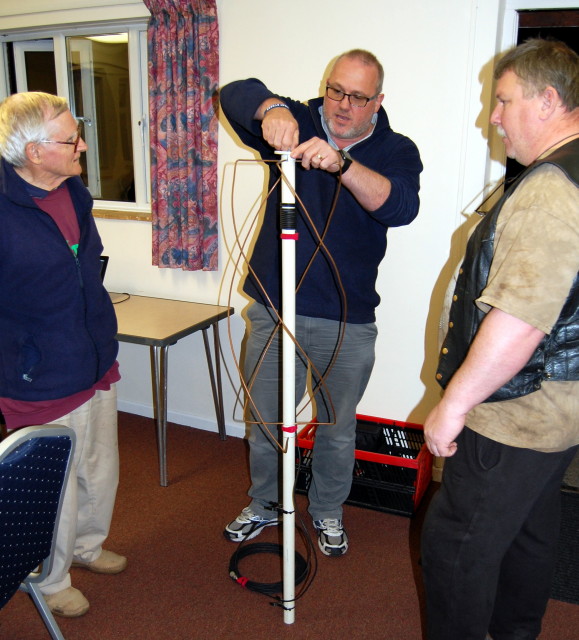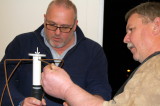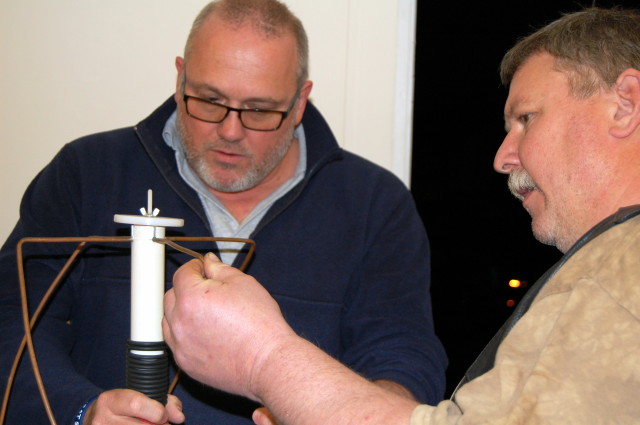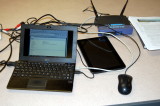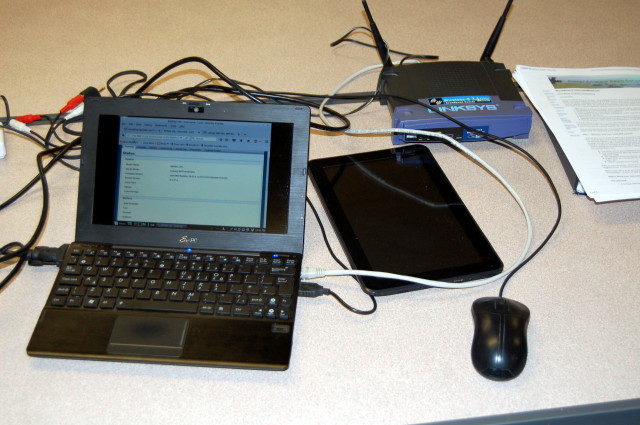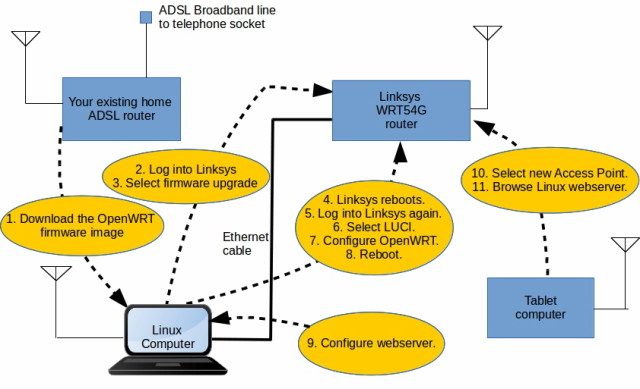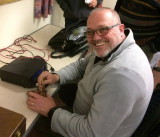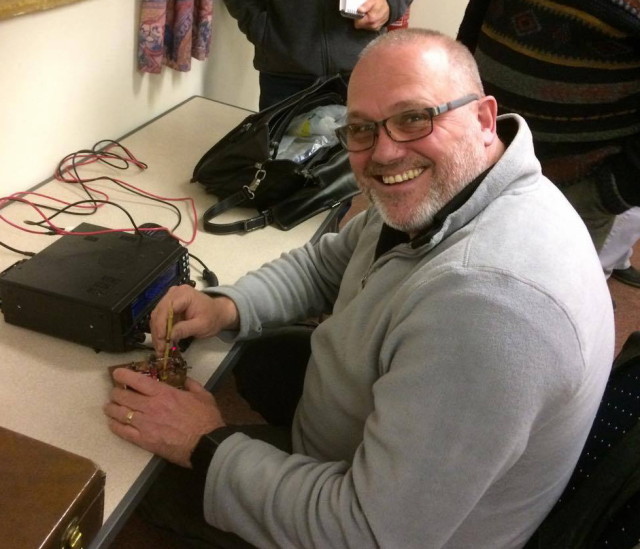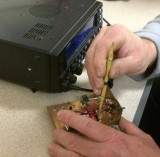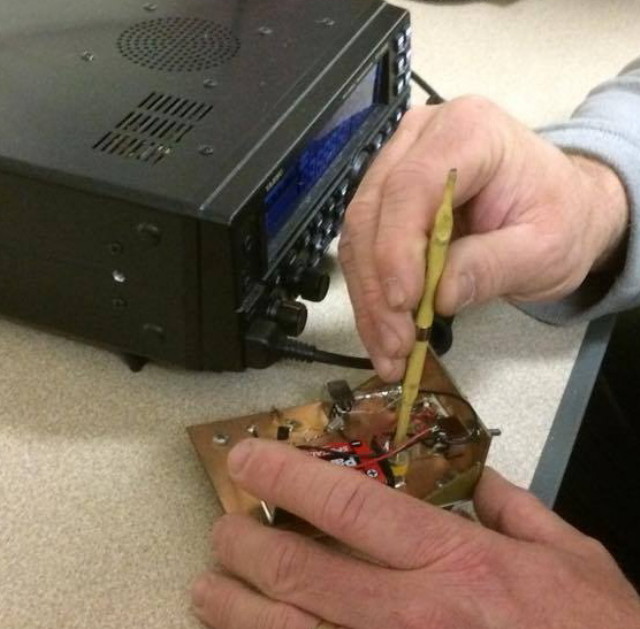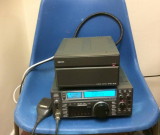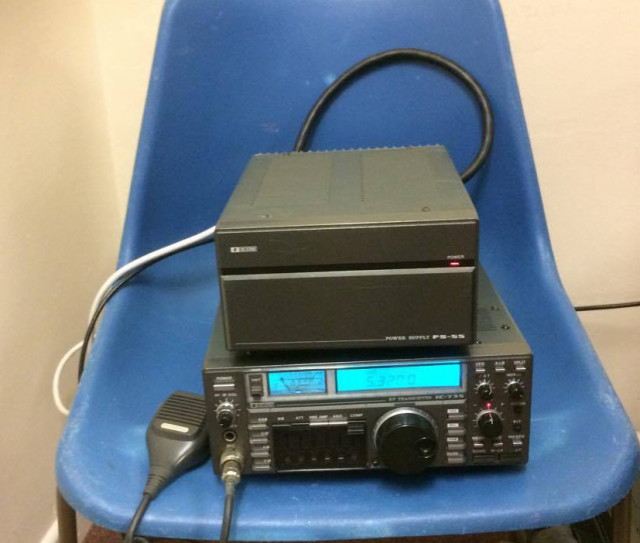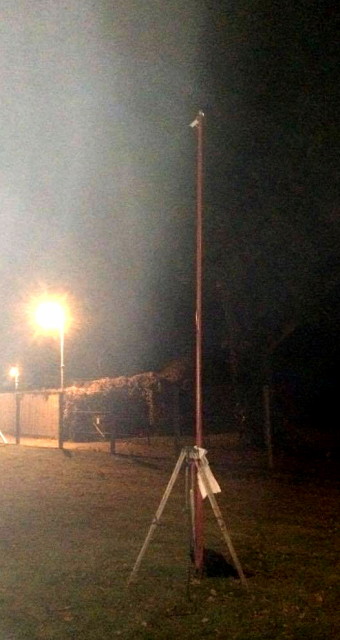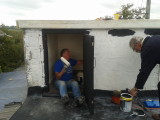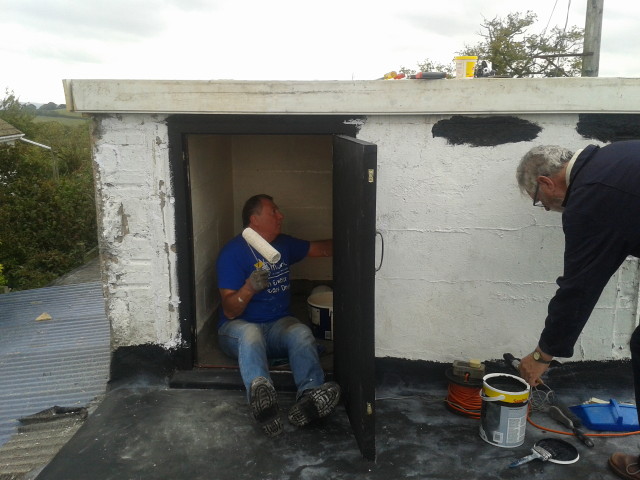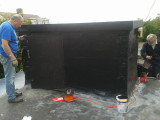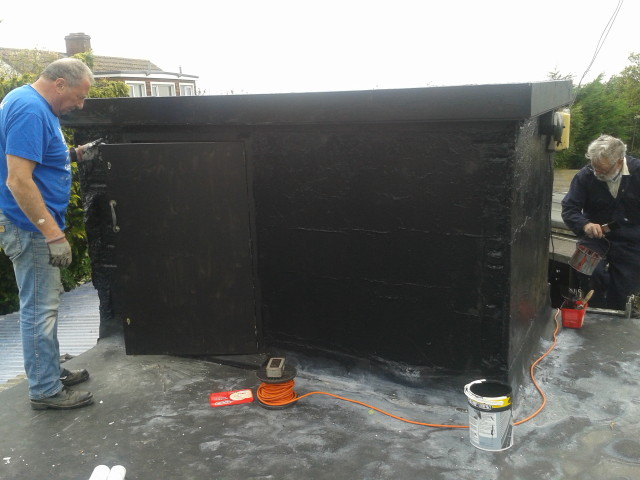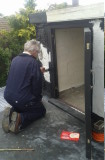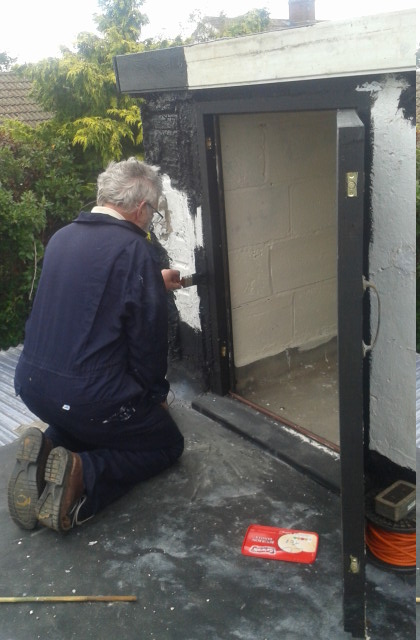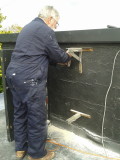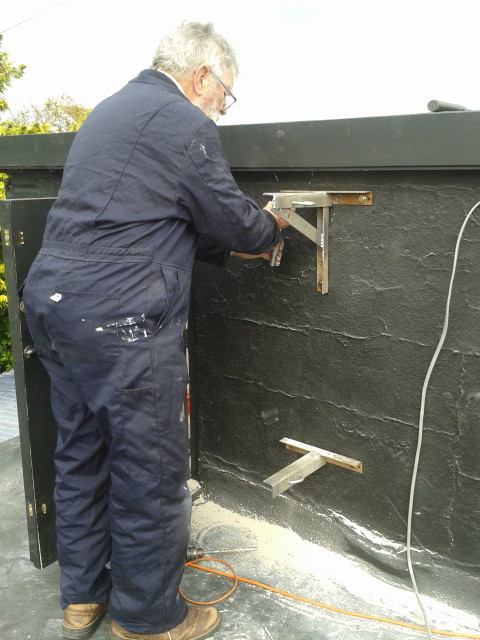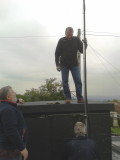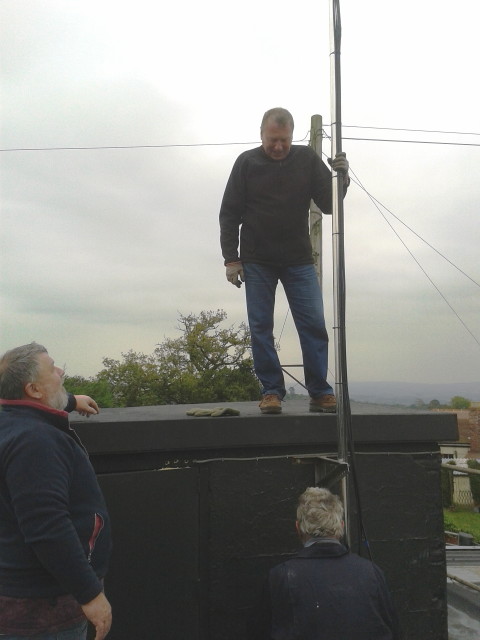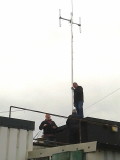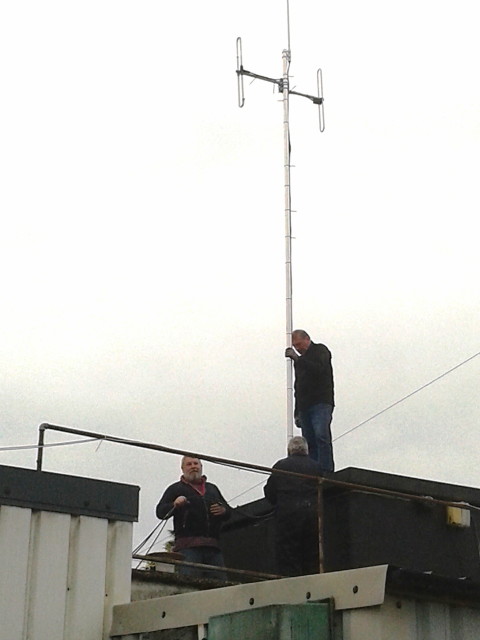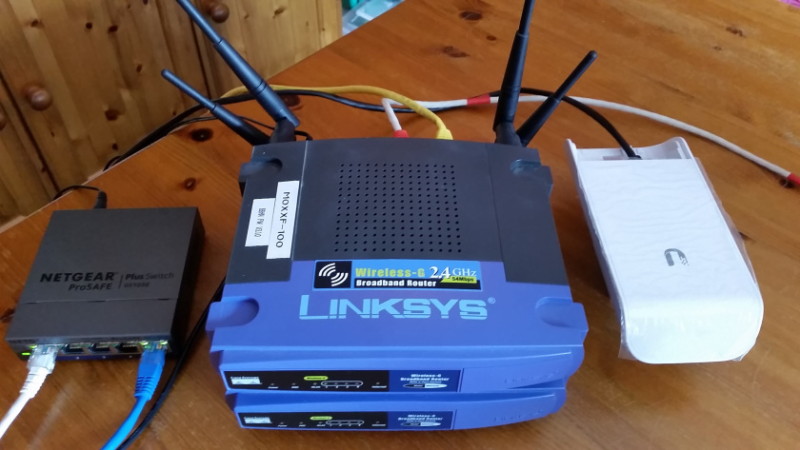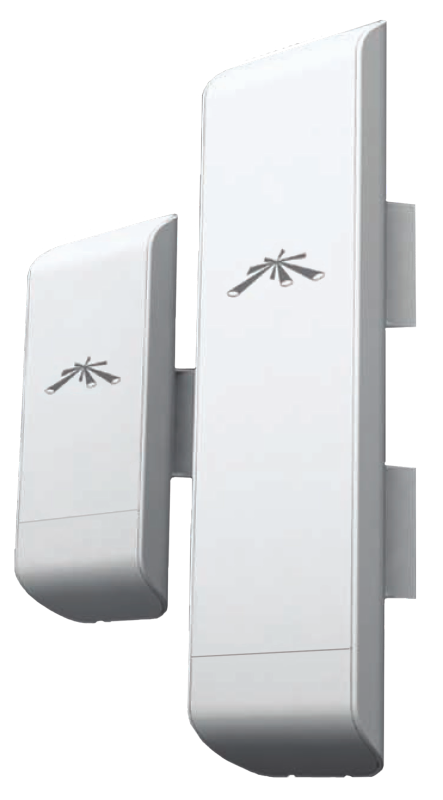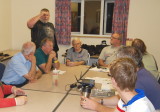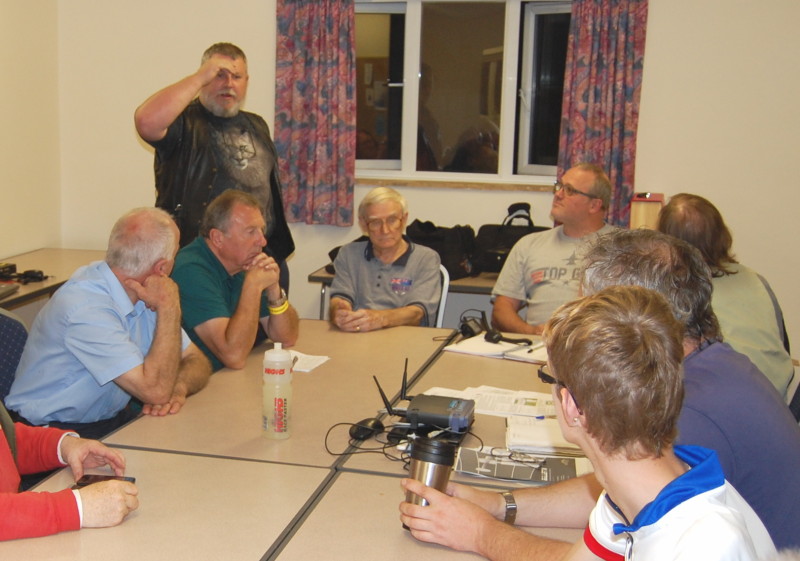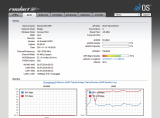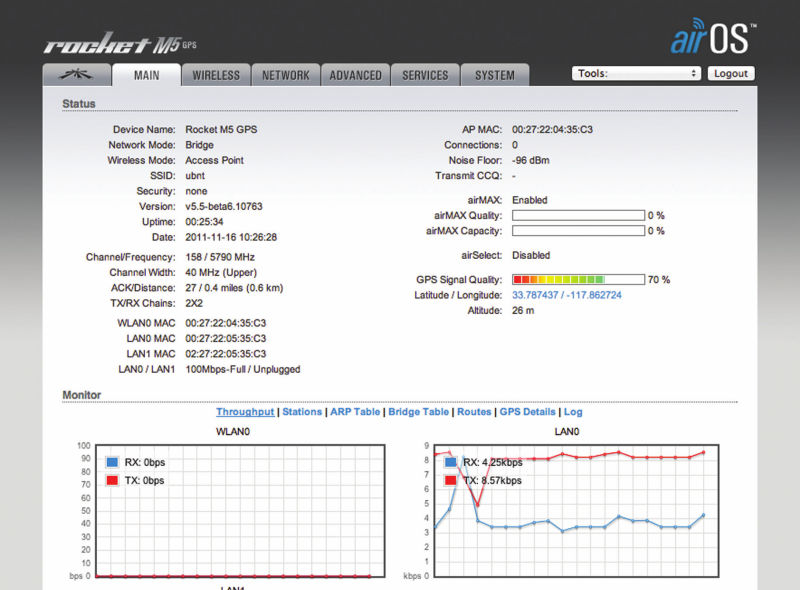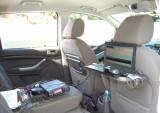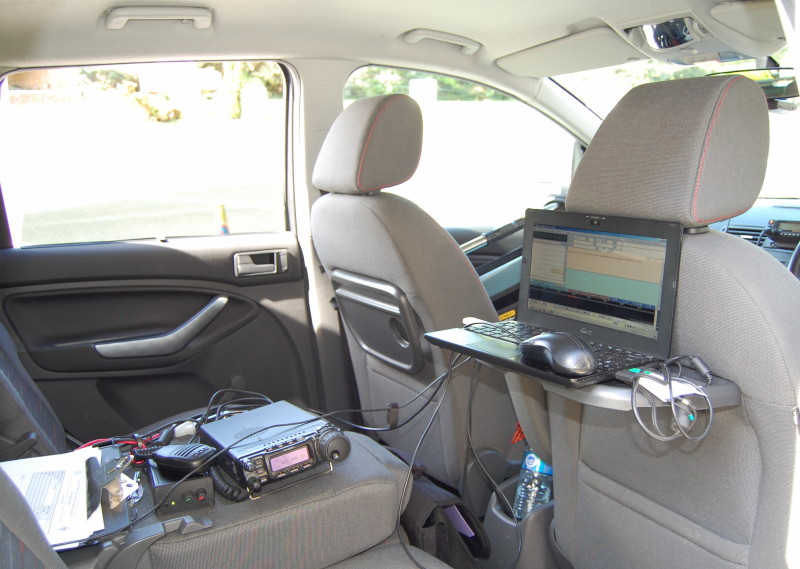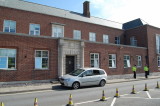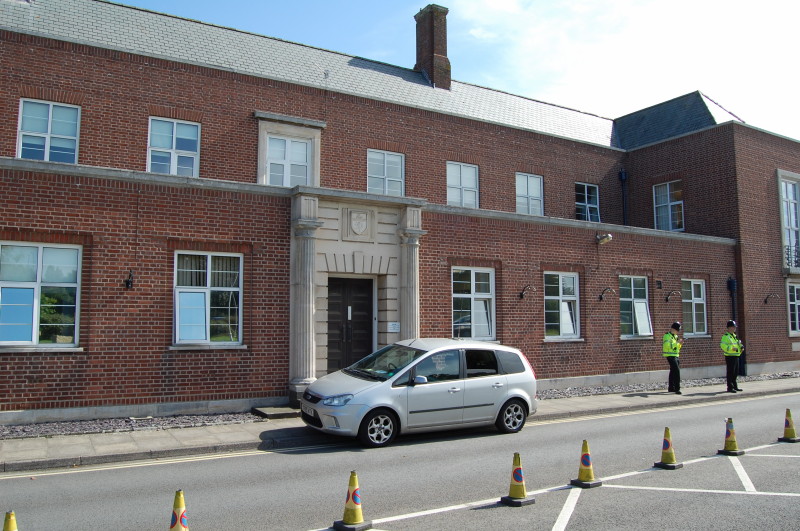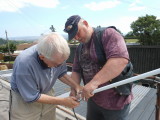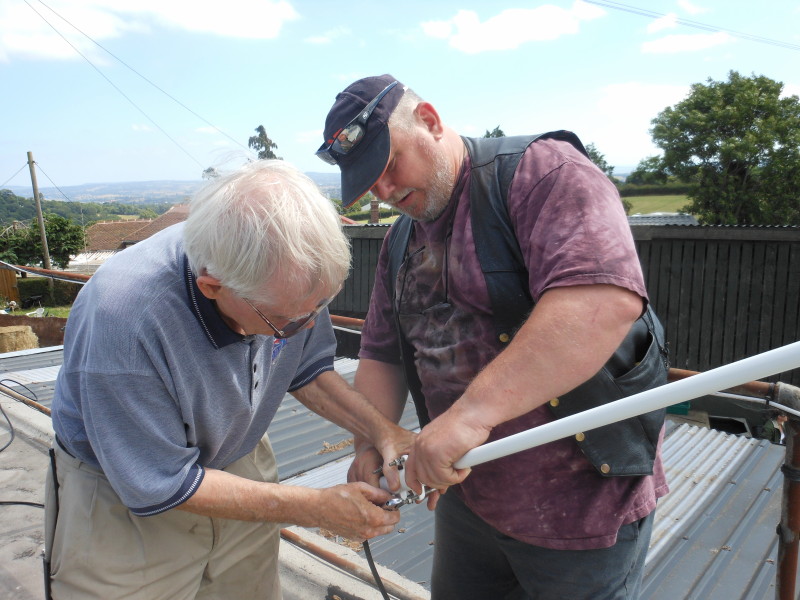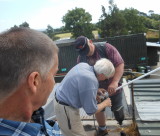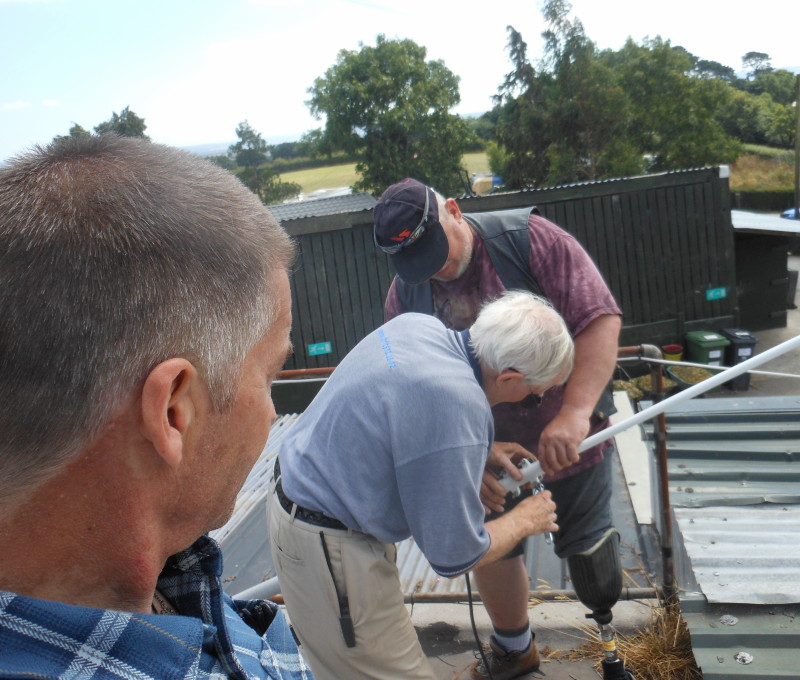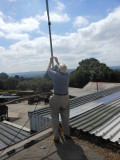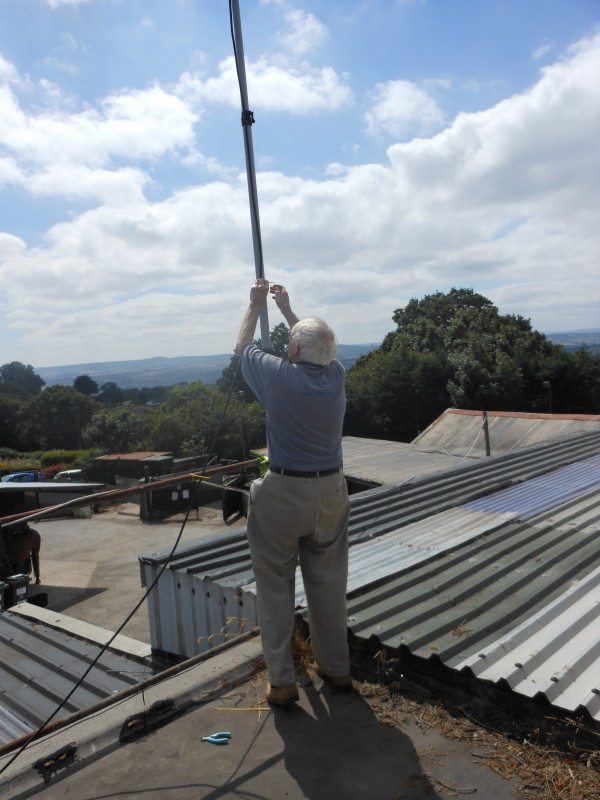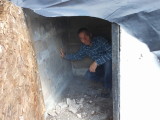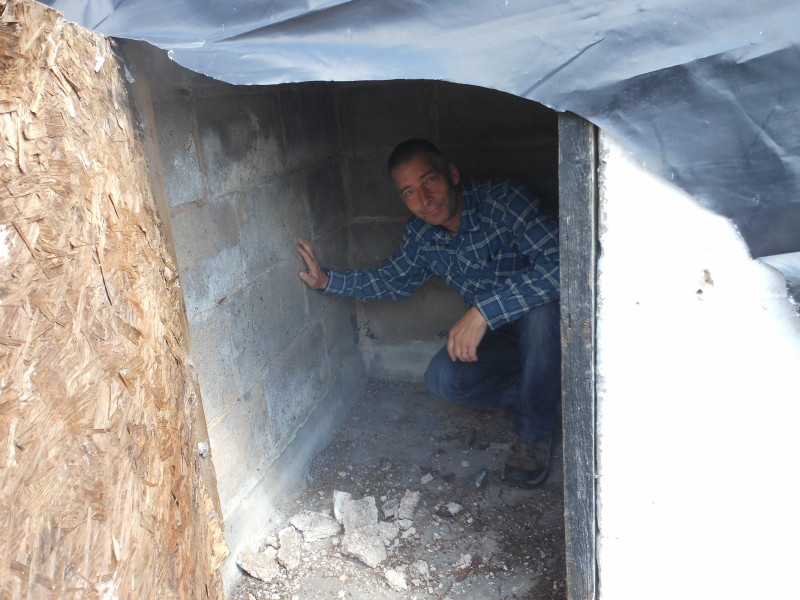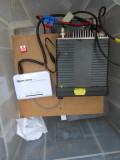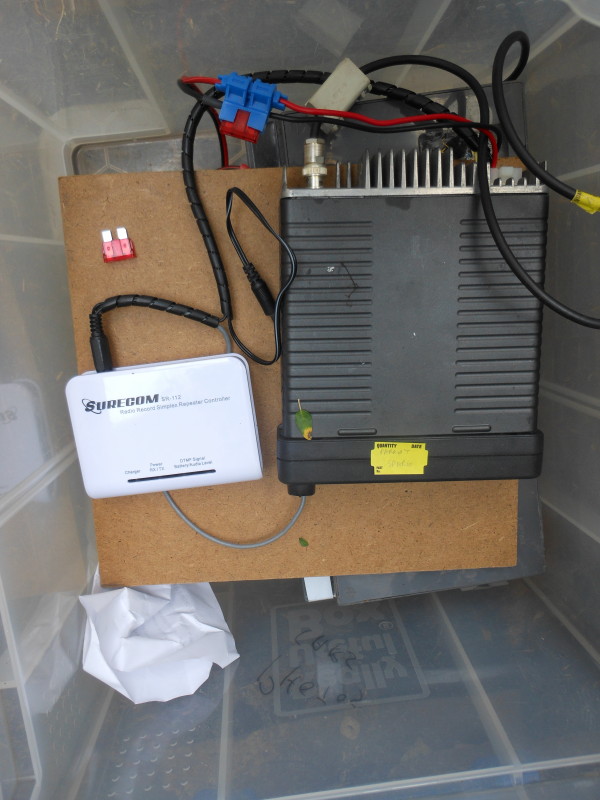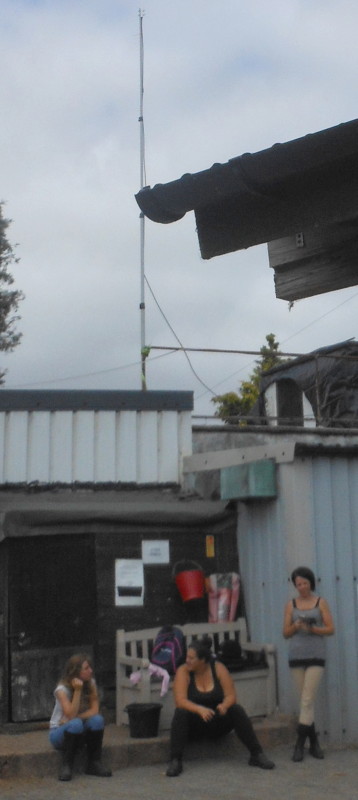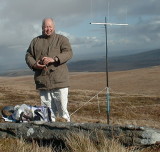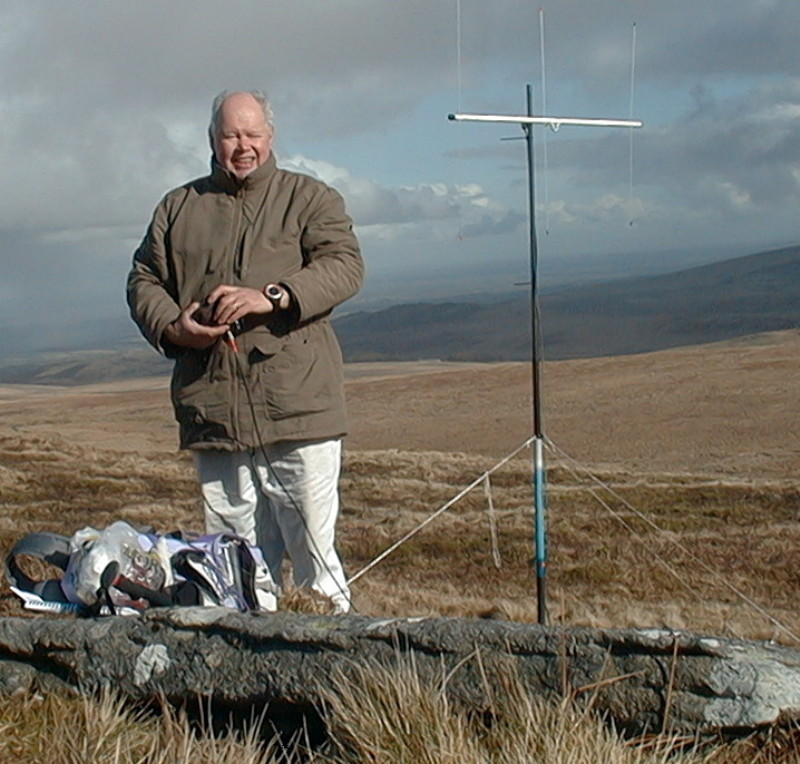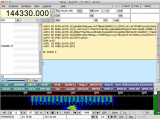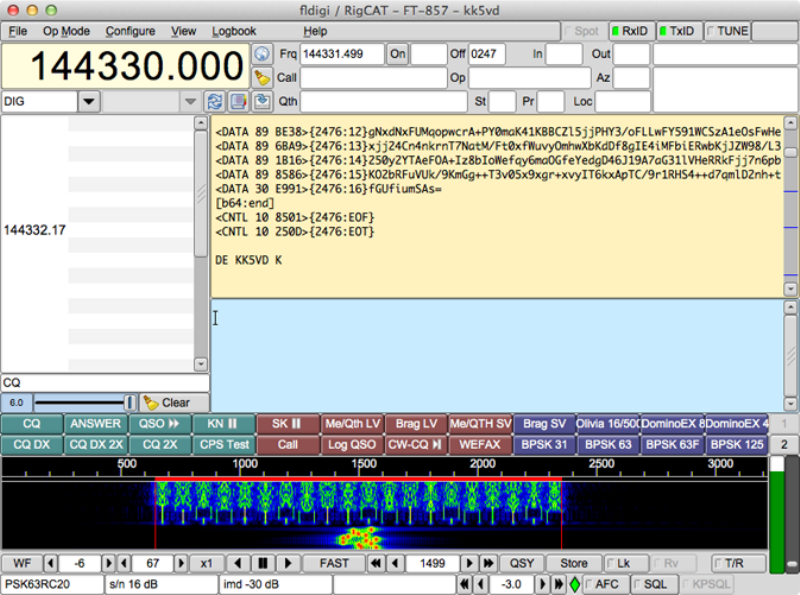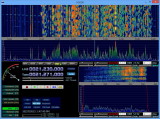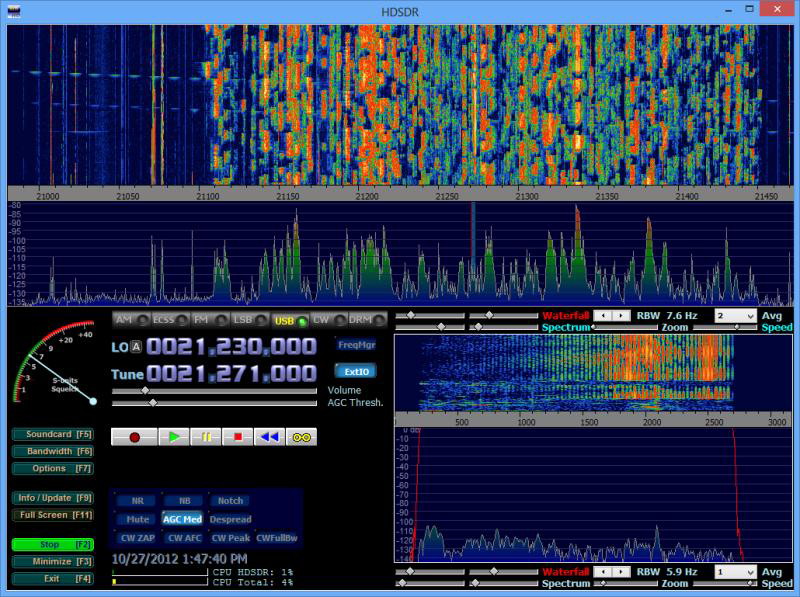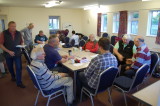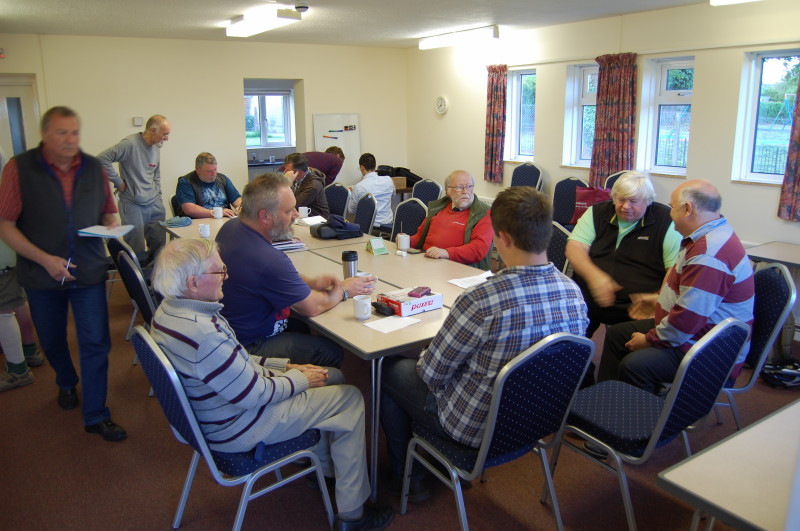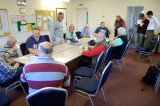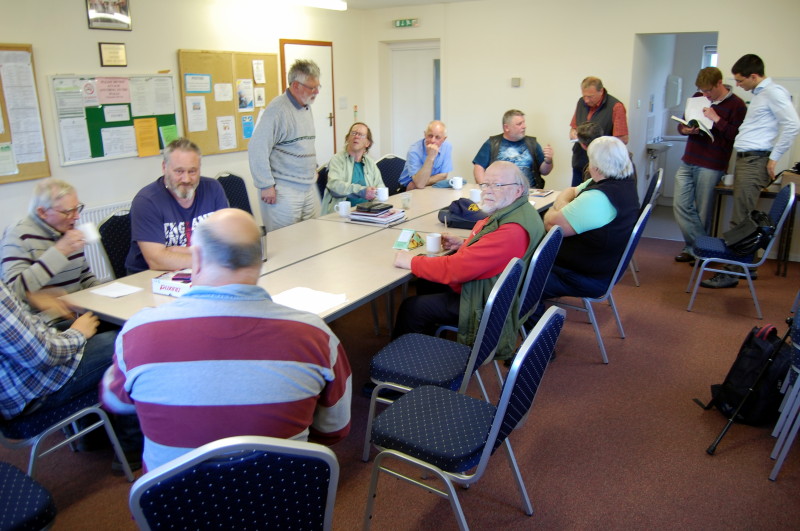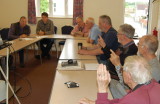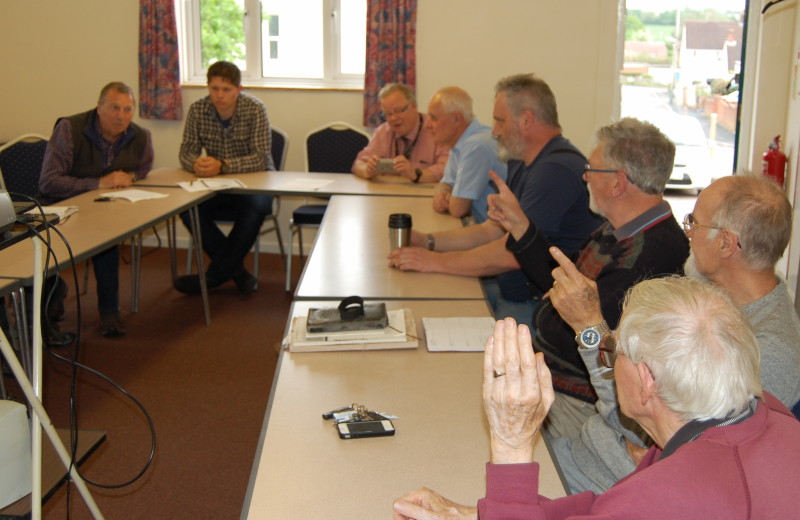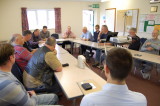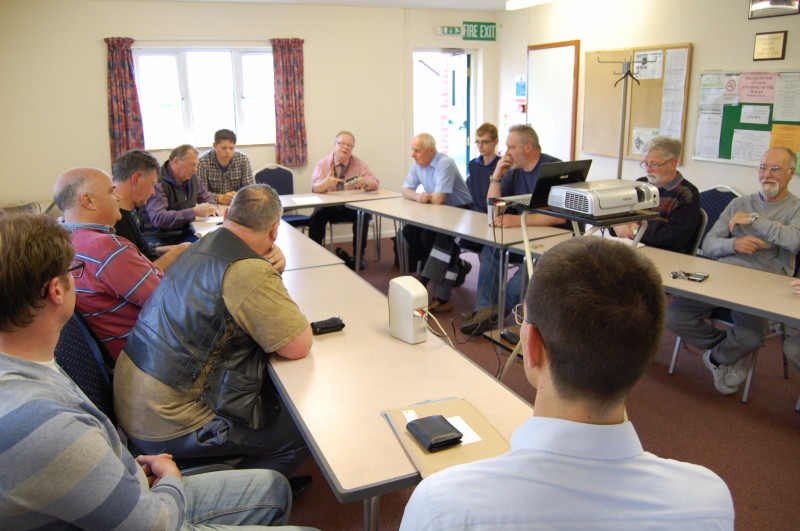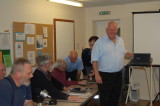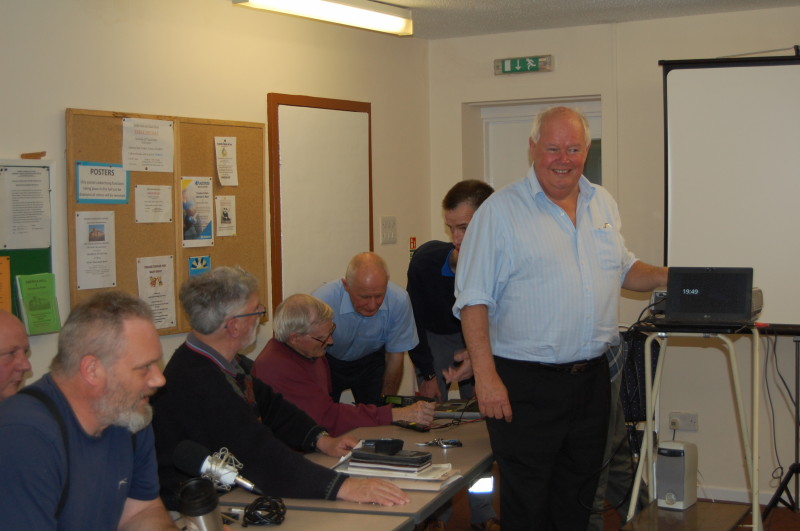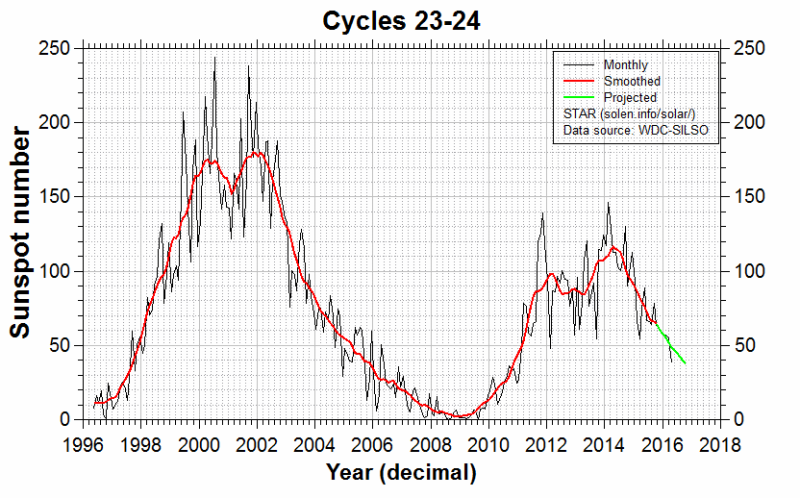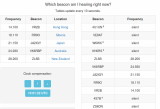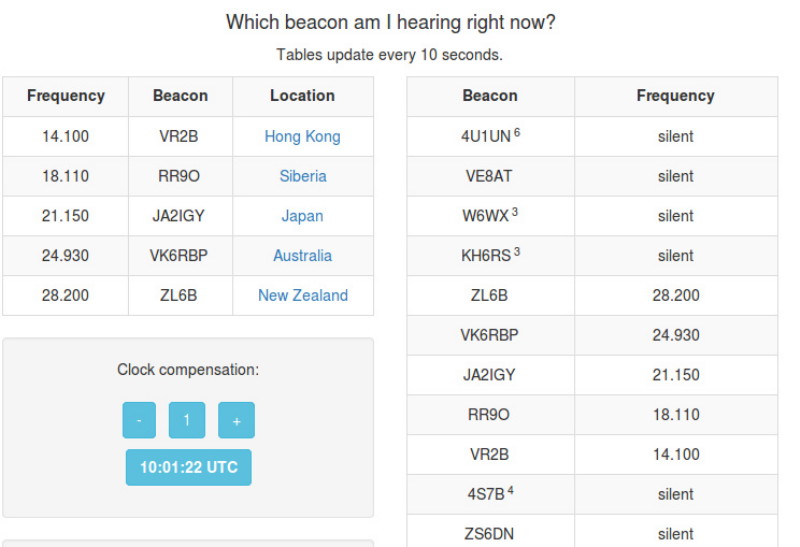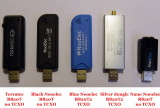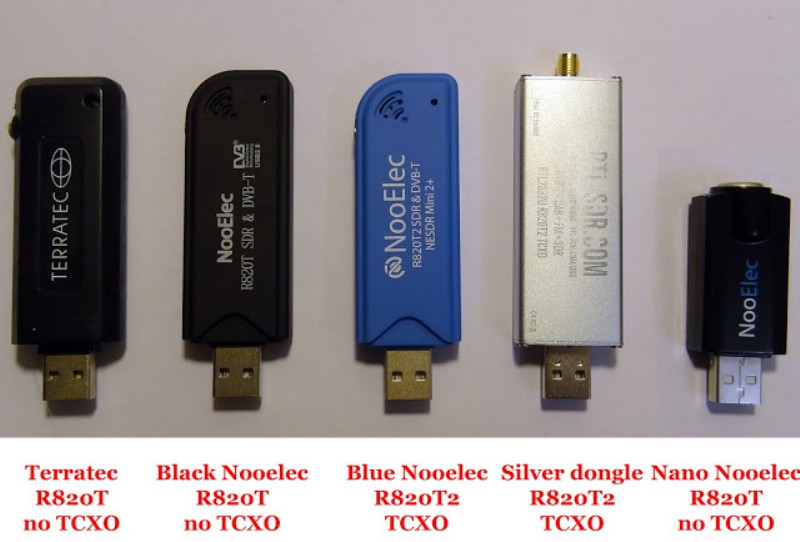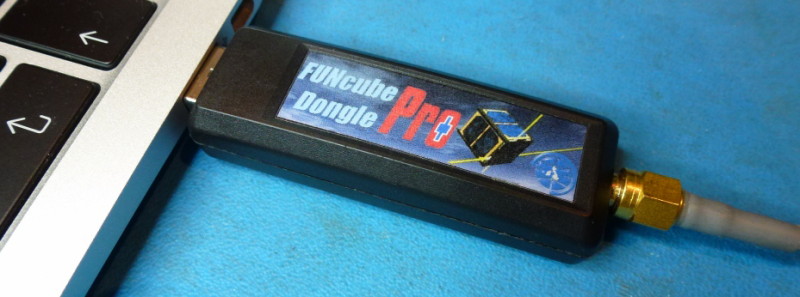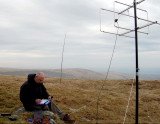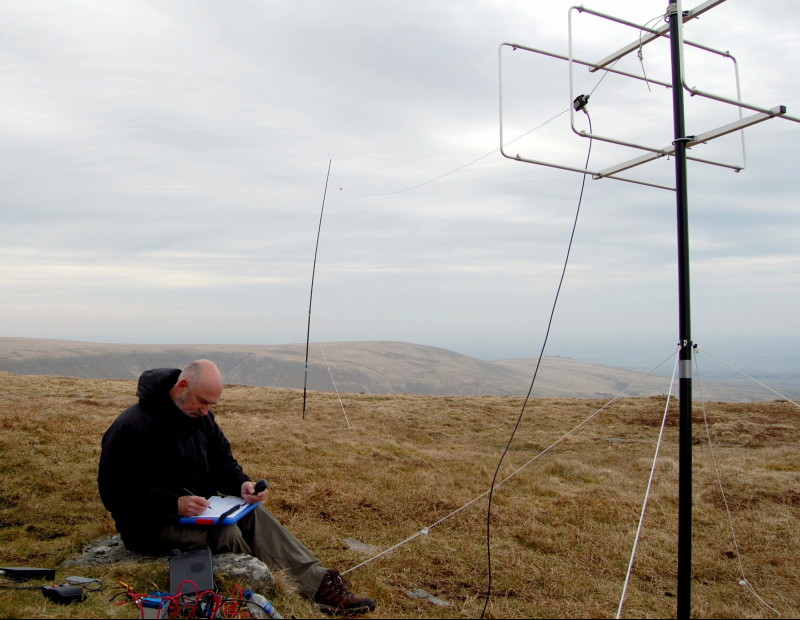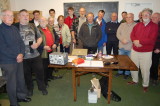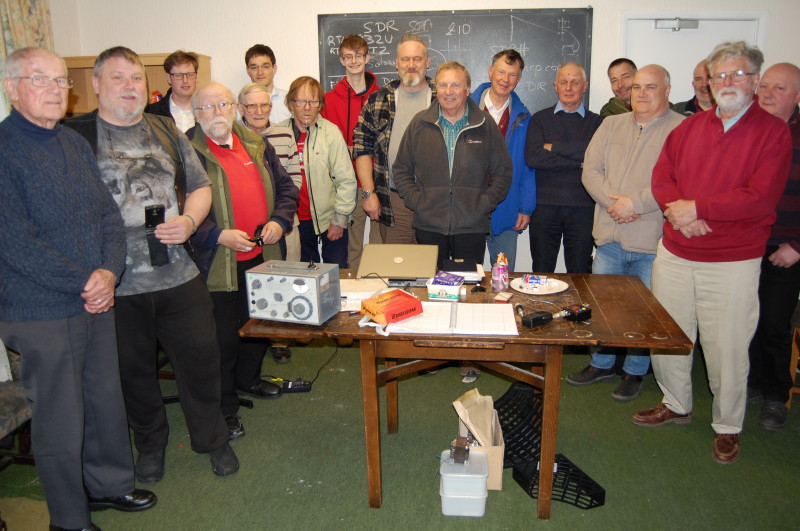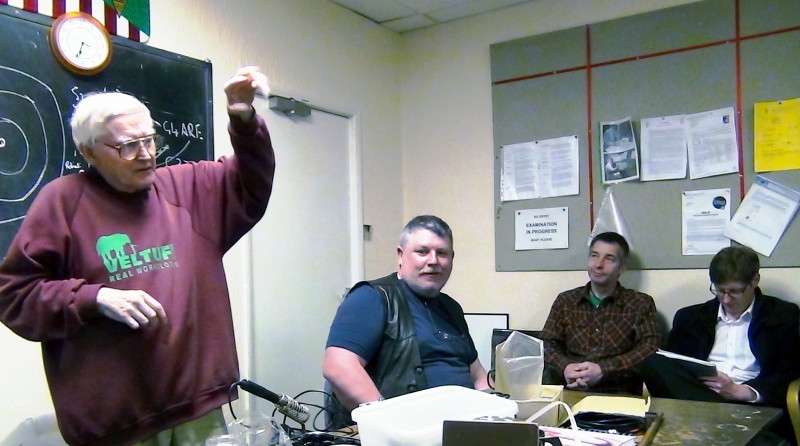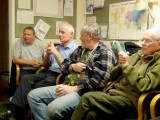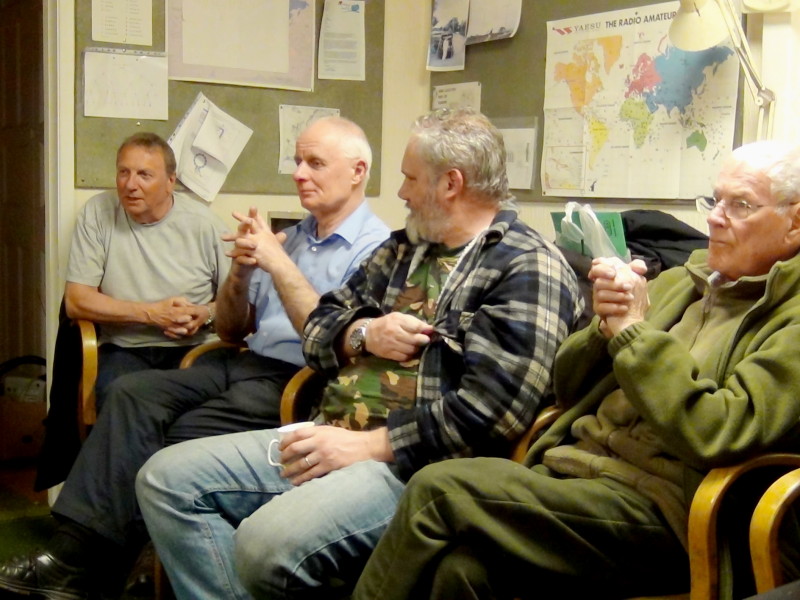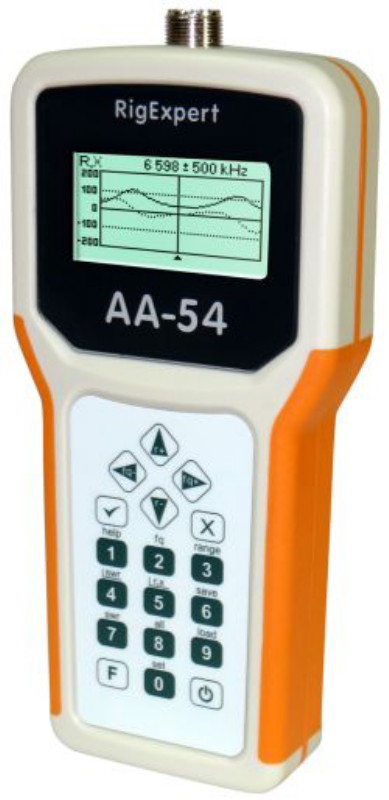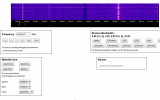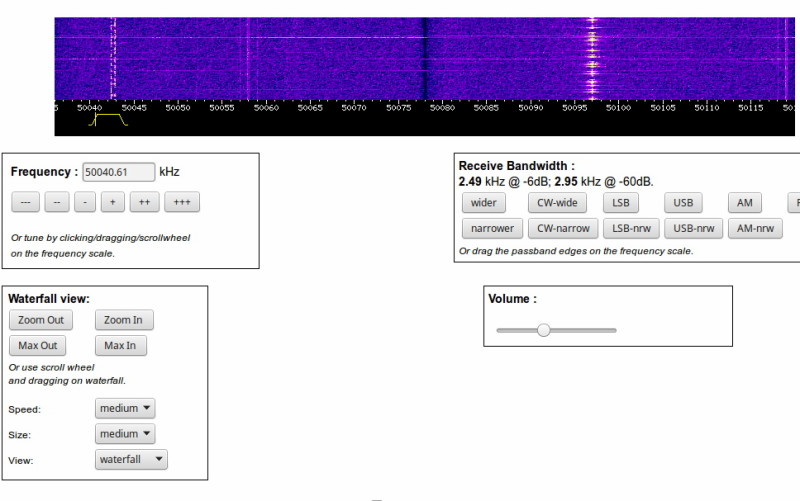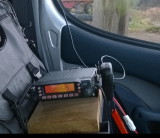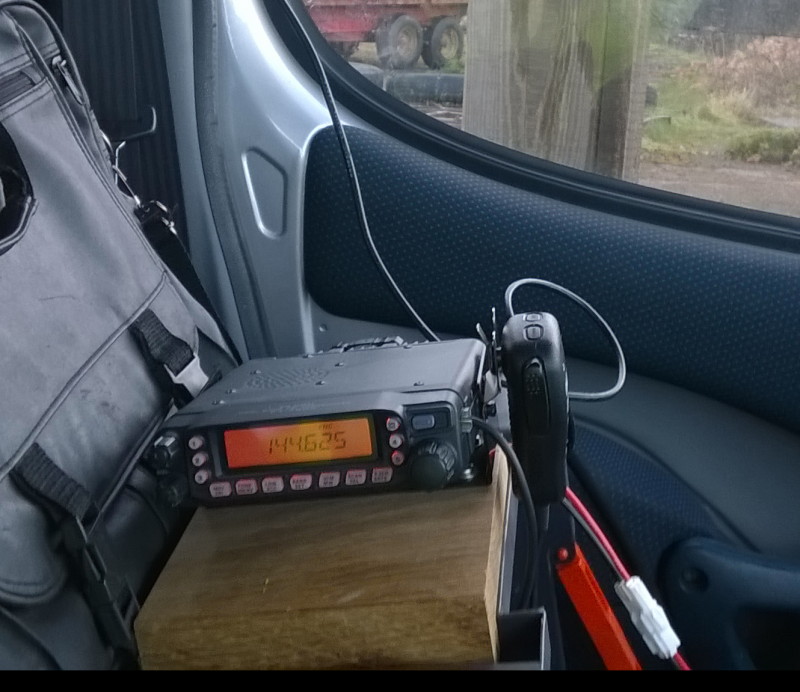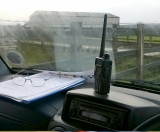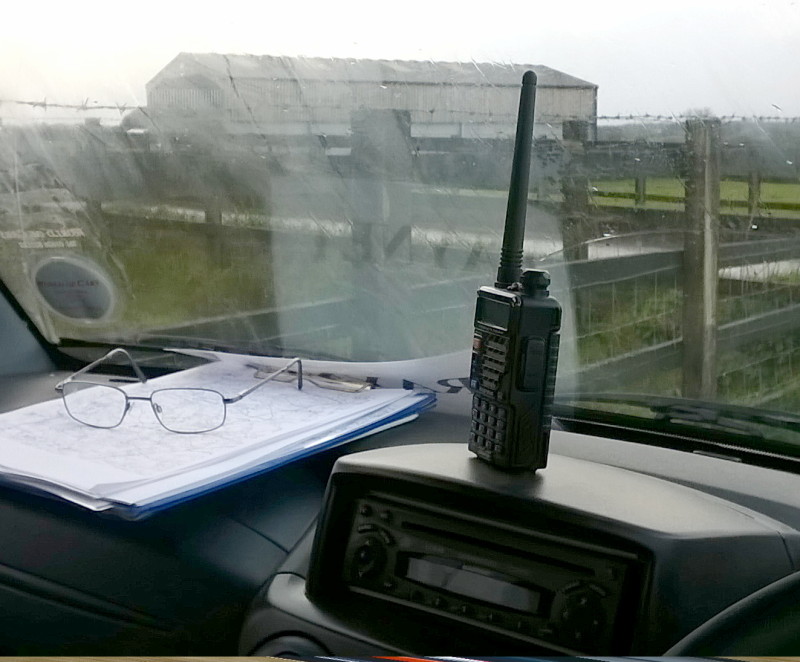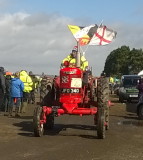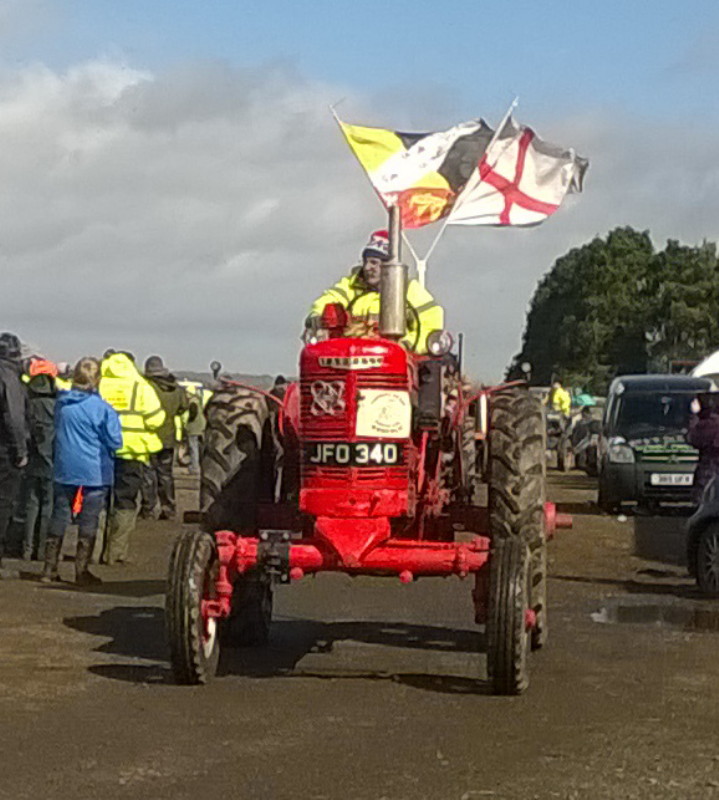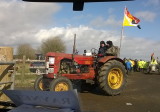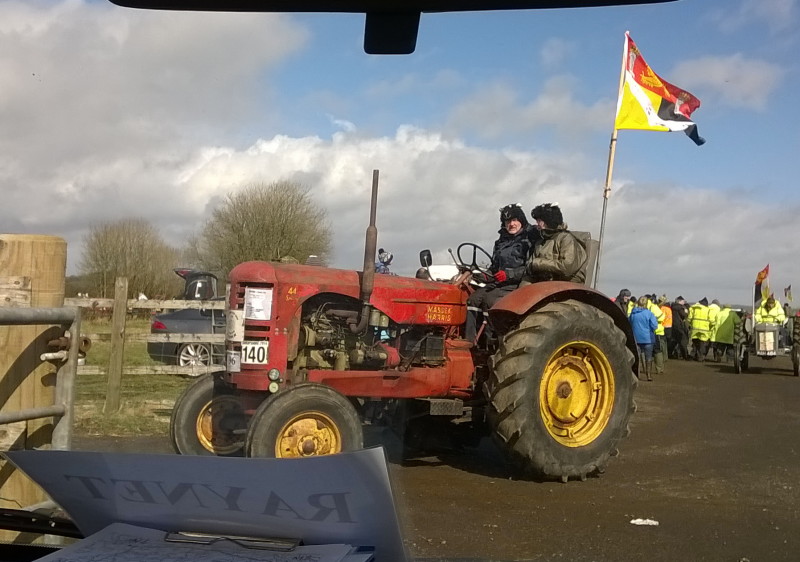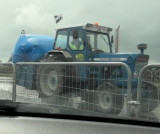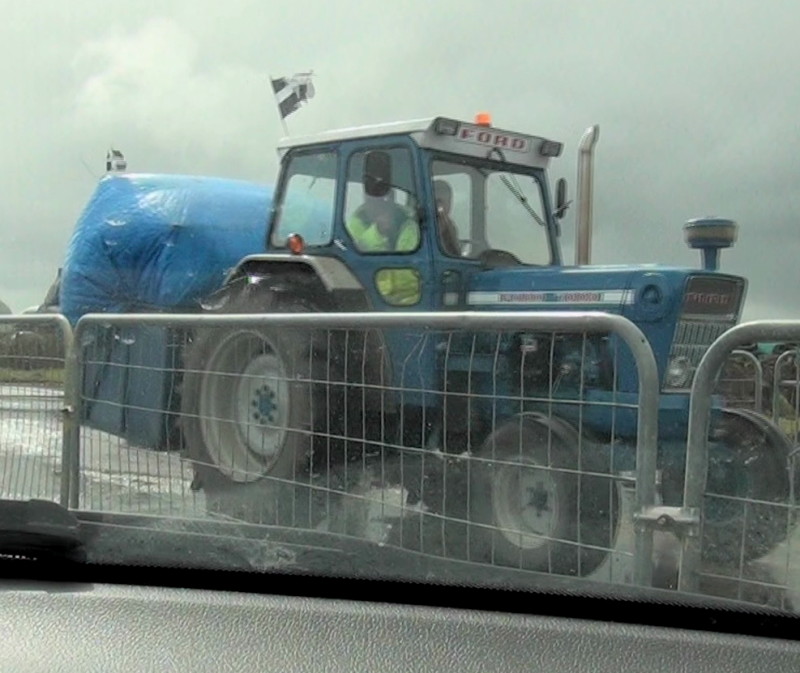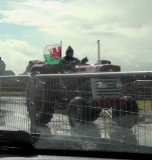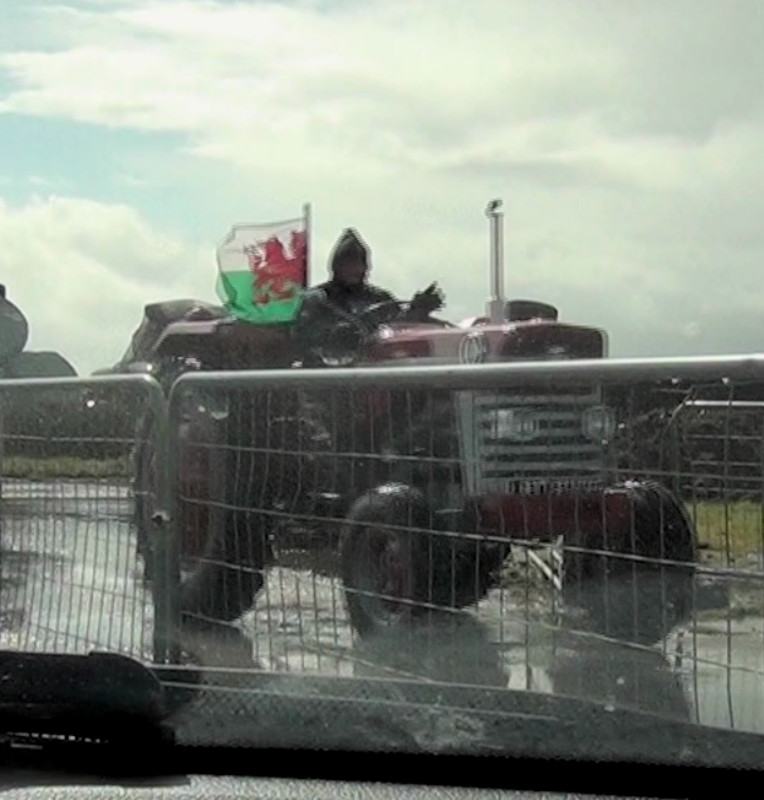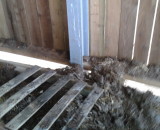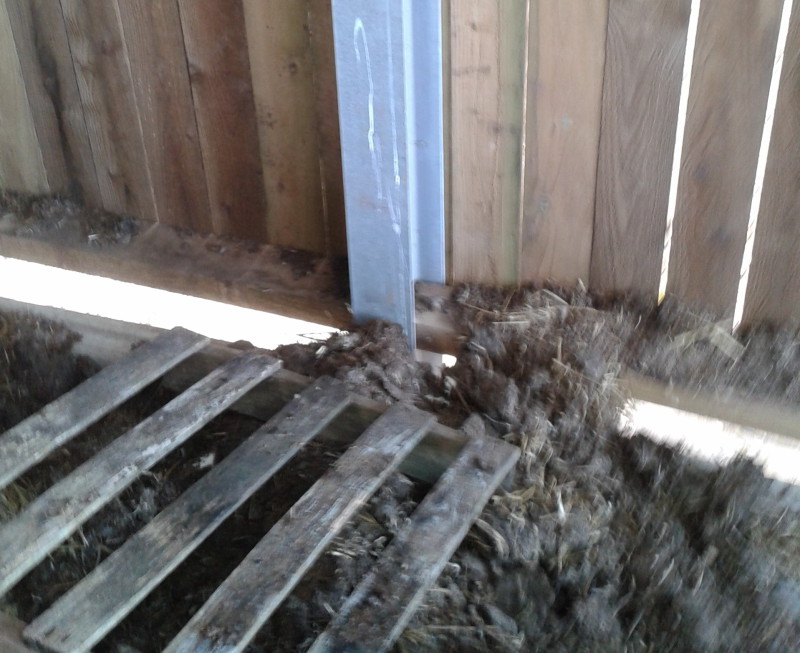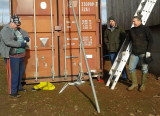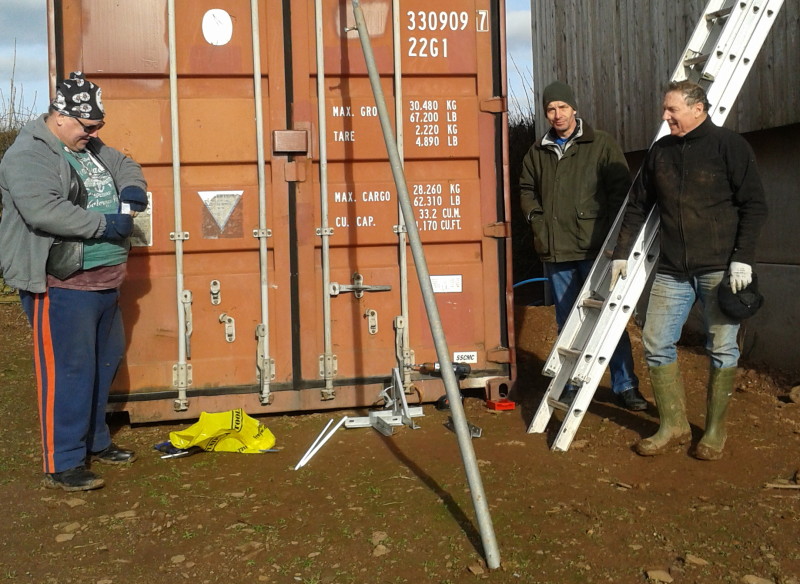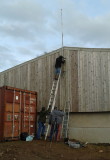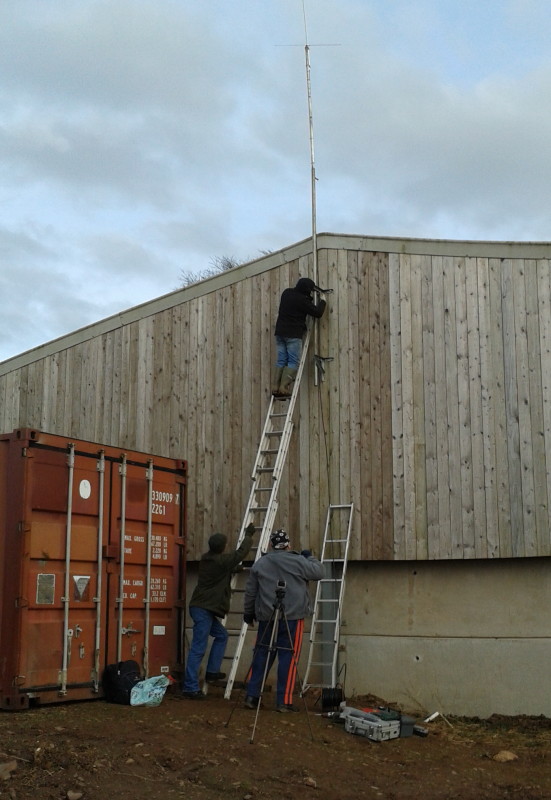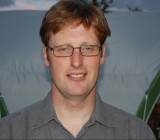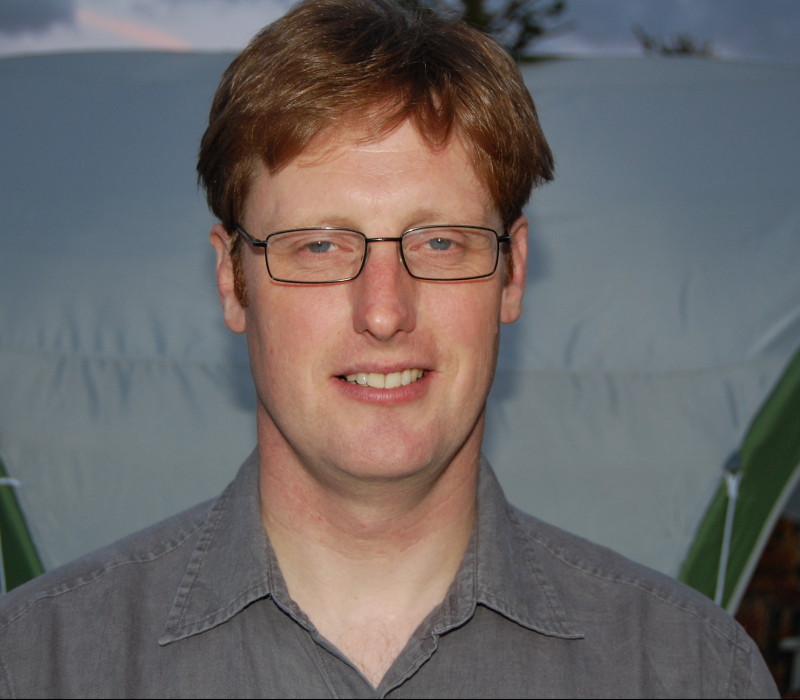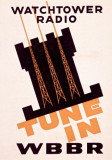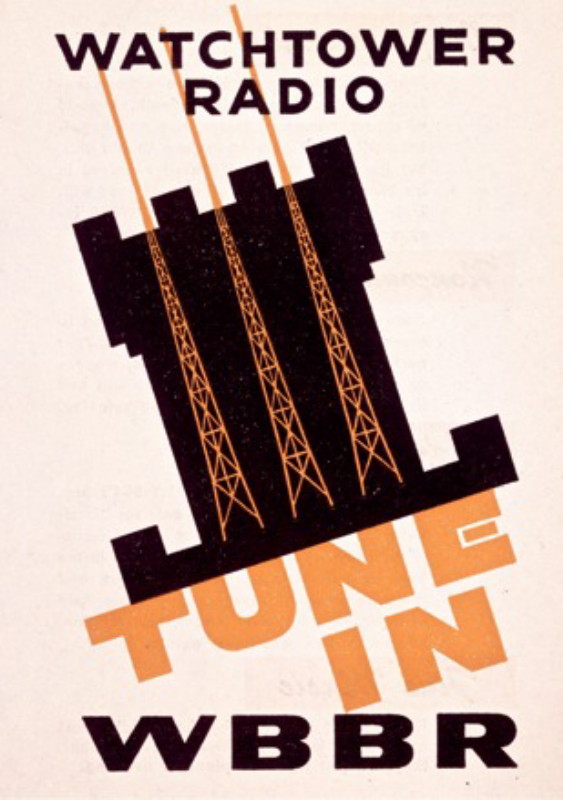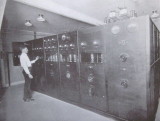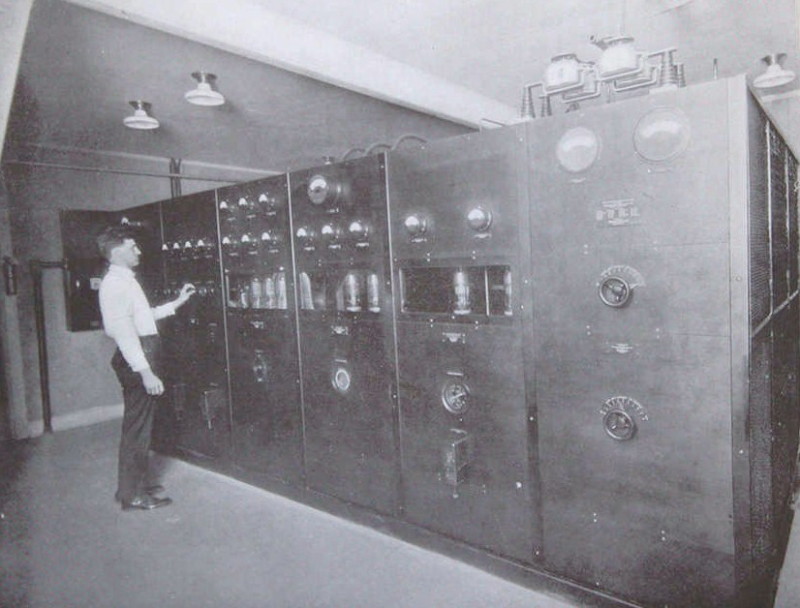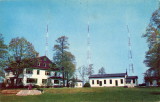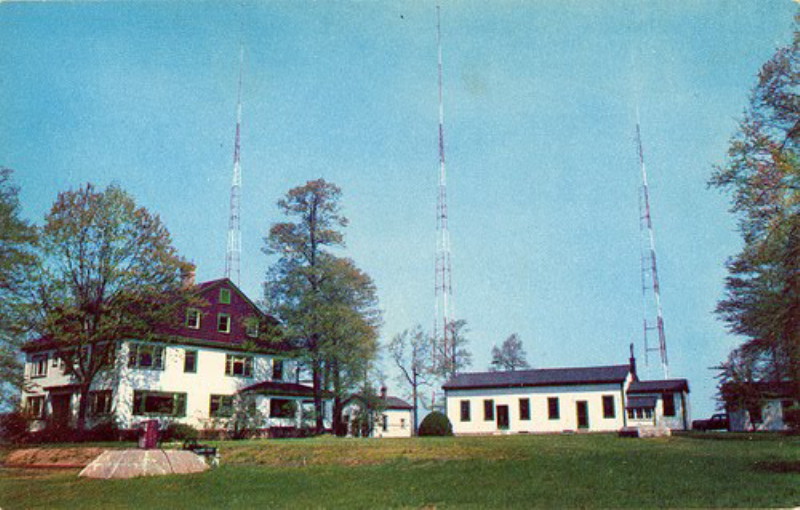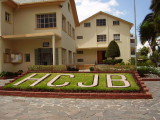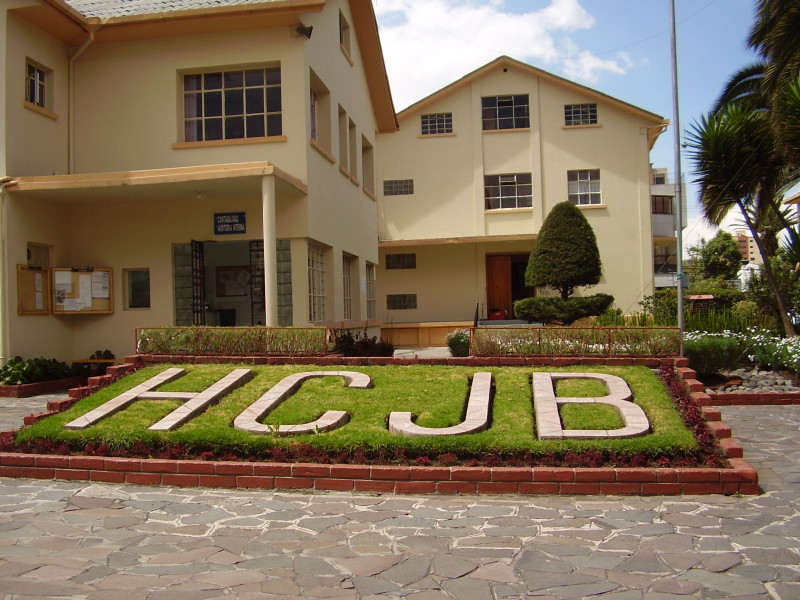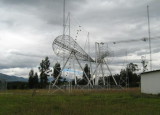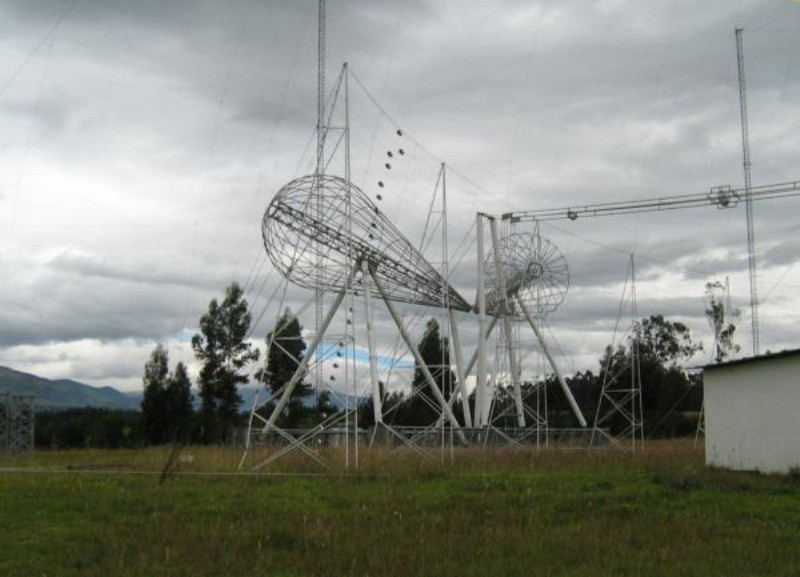
Our club on Youtube
Nets
Raynet
Repeaters
Training
Members only
Devon Shipping Live Map
Devon Air Traffic Live Map
Links
About us
17 December 2016 The Annual EARS Christmas Breakfast was held at Bill's on Gandy Street today. Members with big appetites arrived at 09:00 to tackle "Full English" breakfasts. On the window side of the table and at the head are are Jon G8XTK, Ivor G6ATJ, Keith G7NBU and Tony M0GJX. |
||
On the opposite side are John G4AP, Allan G1JXI, Slade M6SQB, Pete G3ZVI and Bas G0FGE. Nick M0NRJ is lurking with a camera. Many pots of tea and mugs of coffee later, plans for 2017 had been prioritised. Some members left with task lists as full as their tums! |
14 December 2016 The final meeting of 2016 encouraged members to "bring in something interesting." Slade M6SQB showed a wooden aerofoil wing section to prove his skills in woodwork and fabric covering of aircraft as well as repairs using needle and thread. On the end was a fibre glass wing tip which was made using a mould. Aluminium and steel test pieces demonstrated basic skills such as measuring and working to a drawing, filing, drilling, reaming, creating threads, bending metal, riveting and using a variety of fasteners. |
||
Paul G4RRA showed his selection of high power amplifiers including a 1,500 watt valve. He was spared carrying the power supplies into the club as they too heavy to carry. All his amps had seen many years service. |
||
Pete G3ZVI showed a magnificent morse keyer from an 1800's railway station manager's office. He also had a selection of vintage Pye radio manuals. Rob M6UJM had manufactured a fascinating pair of meshed elliptical cogs on his 3D printer. He also showed the mathematics of UK coins (20 and 50p) shaped as equilateral curved heptagons and topped with evening with a home made planimeter. Using a compass and ruler he was able to measure the enclosed area of any randomly drawn closed line! |
||
John G4AP had a heavy duty Megger for testing resistance. Nick M0NRJ dug out his 1983 Timex Sinclair 2068 computer that features a complete home accounting package amongst the vintage games. John G8XQQ showed the old GB3EX repeater, now awaiting refurbishment. |
23 November 2016 Quiz Night at the club tonight, but before the question papers were handed out, Rob M6UJM showed his superb new Buddipole HF multiband antenna to members. It is an elegant, compact, versatile, sturdy and well-engineered system. Bit like Rob, really.... |
||
Members offered ideas for next year's meetings before Lin M0TCF hosted the Amateur Radio quiz. He had compiled question papers for each licence level in the club. After 40 minutes of member's collective head-scratching he collected the papers and will mark and release the scores in a couple week's time. Stay tuned, as they say in radio circles! |
9 November 2016 A truly spectacular evening as Alec G8GON introduced club members to his collection of Tesla coils. He began with the history and theory of Nikola Tesla's invention of alternating current, followed with his research into wireless lighting and electrical power distribution. Soon Alec was showing his collection of Tesla coils and their plasma discharges. From small battery powered coils he built up to his 250,000 volt coil and its arcs. A rotating vane driven by discharges and even music played though the discharges from coils. Many more pictures at our Gallery. Fantastic fascinating science. Many thanks to Alec! |
26 October 2016 Slade M6SQB was delighted to complete connecting his Kenwood transceiver to Fldigi running on his well-used laptop, having solved problems with audio levels. Rob M6UJM brought in two antennas to show his proficiency and craftsmanship in using off-the-shelf components to make good equipment. His dual band Yagi is propped against a chair, showing how a special template and polypropylene cord is used to reinforce the PVC tubing holding the elements. |
||
|
Rob's geometric pipe-bending skills were demonstrated with his home-made quadrifilar helicoidal antenna for NOAA satellite reception using an RTL-SDR receiver and a computer running wxtoimg. Pete G3ZVI and Linden M0TCF studied the elegant use of brake fluid piping to form the rigid curved antenna elements. |
||
|
Nick M0NRJ presented a tutorial teaching Broadband-Hamnet by using a 15 year old Linksys WRT54G router. He showed a five step plan for members to learn the basics of data networking. This included flashing new firmware (OpenWRT) onto the Linksys router. Members also became encouraged to try using Linux. A dual-boot laptop was used to demonstrate the Linux commands used to set up a webserver so that a tablet computer could see web page updates via the new Access Point on the router. This simulated a basic link between mesh nodes. |
12 October 2016 A mixed evening for the club. RSGB Intermediate Examination tests were under way with Slade M6SQB, Rob M6UJM and Alex M6WEK. Linden M0TCF and John G8XQQ supervised as the lads tweaked their 3.5 MHz oscillators to correctly sweep the 80 metre band.
|
||
|
Matt M0SBI set up an inverted dipole outside in the dark with 60 feet of wire to work on 5 MHz band. He installed his new Kenwood rig on a convenient chair and soon had a QSO with a friend in Cullompton. Thanks to Slade for his photographs and editorial. |
5 October 2016 Keith G7NBU led a team of club members (noted for their decorating skills and paint brush selections!), to the new repeater site to weatherproof the cabin. Keith tackled the interior with white paint, then moved onto the roof with the black paint.
|
||
|
John G4AP and Pete G3ZVI (who took the photos) continued with the black painting until they had done a first-class job readying the cabin for the winter. On the second day, wooden pallets were used to build a floor and electrical wiring installed. 'T' and 'K' mast mounts were bolted to the structure ready for the mast. |
||
|
On the third day of work, the mast was rigged by Linden M0TCF, John G3AP, Pete G3ZVI and Keith G7NBU. Now the feeder cables ned to be terminated and harnessed. An electrician will visit soon to provide power from the building below. Then it will be ready for the relocation of the GB3EW repeater. |
28 September 2016 Linden M0TCF, the EARS Training Officer, ran the club's first Buildathon! He provided mini-kits for members to construct and hone up their soldering skills. Much fun was had as resistor colour codes were recalled, electrolytic capacitors polarities were checked and construction instructions decoded from circuit diagrams and component lists. |
||
John G3WVM and Stuart G3XYO built QRP Pixie CW transmitter kits. Norman M0NJE built an audio preamplifier and Rob M6UJM built an RF amplifier. By the evening's end, most were able to power on their devices and hear the signal outputs. Thanks to Linden for the excellent organization and assistance. This could be a regular event as so much was learned in such a companionable way. |
14 September 2016 Nick M0NRJ introduced the EARS club members to a new challenge of using 2.4 and 5.4 GHz frequency bands to provide a high speed data mesh net. Following on from pioneering work by UK, German and American clubs he explained the range of new topics to be mastered. Using recycled Linksys WRT54G routers, cheap Raspberry Pi 3 computers and Ubiquiti Nanostation Customer Premises Equipment SHF links, Nick showed how members could develop nodes to both learn on and then join a local mesh network. |
||
Using resources such as 2E0FDU's excellent website, with tuition in data network fundamentals, Nick proposed the investment in this new technology to develop club capability in the use of SHF operation and high speed mesh networking. The Amateur Radio Emergency Data Network (AREDN), the Scottish FEEDNET and Broadband-Hamnet all provide excellent online reference material. Facebook and Google+ groups also offer discussion and new developments. |
14 September 2016 Exeter Raynet members Keith G7NBU and Nick M0NRJ provided data and voice communications for a Devon county emergency services exercise. The radio car was stationed in front of Middlemoor Police HQ in Exeter for the day and delivered data at 250 bps over two repeaters to Plymouth.
|
3 September 2016 Exeter Raynet members provided core communications to the Moor2Sea Sportive Cycle Ride, operating from the Control Tower at Exeter Racecourse. Keith G7NBU and Nick M0NRJ assembled antennas, cables and radios on the roof and top floor of the tower. They provided a UHF/VHF link to Bellever on Dartmoor, with a PMR service for the race organisers around Haldon. A 4m backup network was also operating across all race locations using a mobile unit provided by Linden M0TCF in the medic's car.
|
||
On the 110 km course looping around Dartmoor, Norman M0NJE and Slade M6SQB assembled a UHF/VHF relay near Warren House Inn to link back to the towering masts at Raynet Control. At Bellever Youth Hostel in the centre of Dartmoor, Pete G3XVI set up both a UHF base station and a backup 4m station, that could communicate directly to the racecourse when the weather was clear. Morning sunshine did not last long and degenerated into a raging gale with horizontal rain. Masts began to lean in the gale but stayed up, keeping the system operating throughout the 10 hour event.
|
||
At 12:30 the gale gusted strongly enough to blow over the line of guard rails guiding the 1,000 cyclists to the start/finish line. Staff rushed to clear them as the first riders completed the route before the heavy rain arrived. The control tower masts leaned to an even steeper angle. Although the mast height was superb for radio operations it meant quite a bit of climbing up and down for that spanner or sandwich down below!
|
||
Keith is seen in the uppermost control room while checking on weather conditions. Fortunately by the time de-rigging began the storm has passed through. A the start/finish line cyclists gathered to swap experiences and then head into the restaurant/bar to tell their families of their adventures. Race organisers were delighted with Exeter Raynet's work, especially dealing with cycling accidents in the challenging weather. Team members were able to provide critical first aid as well as on-the-spot situation reports.
|
24 August 2016 Club members bought in their UHF/VHF handies to show the huge range available on the market. Baofeng, Wouxun, Yaesu, TYT. Icom, Kenwood, Hytera, Alinco models are available, so this session was useful to hear which models are most frequently used. Topics discussed between members covered power settings, battery life, programming software and quality of the supplied manuals. |
||
Programming sessions demonstrated how the supplied programs for managing memories in handies were often buggy and had poor English translations. Getting the correct Windows parameters for serial ports was difficult but critical. CHIRP showed how a single program, with the correct interface cable, could be used to manage several handy models. Bi-weekly updates ensured that it covered practically all models on the market. Pete G3ZVI bought in the service manual for the first ever "Walkiephone" - the 1951 era Pye PTC122 (60 - 100 MHz, 100 mW, 6 valves and 5 kilos). |
14 August 2016 Club members assisted Pete G3ZVI with his installation of equipment to validate a new repeater site. |
||
Linden M0TCF and Allan G1JXI helped assemble a mast and antenna looking over the Exe river valley. Allan explores the temporary equipment housing. |
||
A Parrot repeater and small transmitter were fitted into the housing and other club members (Keith G7NBU and Nick M0NRJ) went off to measure field strengths. The system was dismantled a day later. Thanks to Allan G1JXI for taking the photos. |
10 August 2016 Club members enjoyed listening to experiences of portable radio equipment used for Field Days and Summits on the Air. Linden M0TCF related his recent experiences operating a Field Day trying out new antennas using fibre-glass masts. Paul G4RRA explained the challenges of rigging a sixty feet high mast and typical problems that are encountered, such as forgetting the fourth guy line. |
||
Stuart G3YXO demonstrated his home-brewed fibreglass mast support. Using a loudspeaker tripod, he manufactured an adaptor bracket and tuning unit. This is for use with his 3 band QRP transceiver. Nick M0NRJ demonstrated a Sotabeam VHF/UHF Yagi that is not longer available, but folds away to three lightweight tubes. The picture shows it in use on High Willhays, Dartmoor. |
5 August 2016 Linden M0TCF led his team of five operators for a 36 hour extraordinarily successfully Field Day (and Night) on Stoke Hill. His first-hand account of the weekend is a "must-read" and perfectly captures the excitement of a great field day when the weather is in your favour. Special thanks to Slade M6SQB, Bas G0FGE, John G4AP, Rich and Jay for making the weekend work so well.
|
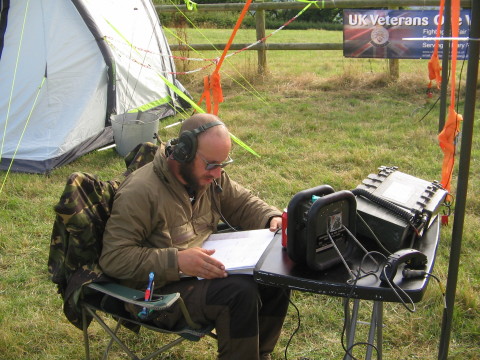 |
27 July 2016 Members brought in their rigs so that they could be tested and calibrated against professional equipment. John G8XQQ used his mighty Marconi Instruments 2955A radio communications test equipment to check power levels, frequency calibration, CTCSS tones and more. |
||
Stuart G3YXO demonstrated his portable 12 volts supply generated from LiPo batteries and a £12 charger for them that he has adapted. Pete G3ZVI used Chirp software to try and set up a Yaesu FT-817 transceiver for John G8XTK. However, having conquered the CAT interface bit rate settings he found that the RS-232 to DIN cable he had was not the correct one for this equipment. |
||
Prospective new member Kevin and his XYL joined the meeting to get a flavour of what members enjoyed doing with amateur radio. They were offered advice on starting to study for the RSGB Foundation Licence exam, buying equipment and the many aspects of the hobby from moon-bounce to Raynet to satellite operations. And of course the club's 2 metre nets on Tuesday evenings. |
26 July 2016 The Sidmouth Amateur Radio Society hosted the first annual Desert Island Challenge and invited teams from amateur radio clubs in east Devon to compete. The Exeter Amateur Radio Society team won first prize! Well done to Captain Pete G3ZVI, Slade M6SQB and Linden M0TCF! Slade was voted "Man of the Match". Thanks to Allan G1JXI for the photographs. |
||
The challenge was to build a flashing light device and launch it across the car park. Two rules: 1. Only use what is in a supplied box. 2. There are no rules. Using ingenuity and cunning they managed to get their device 12 metres across the car park. Observer John G8XQQ and John G4AP were there to oversee the event. |
| 23 July 2016 The 2016 Exeter Amateur Radio society BBQ was held at Keith G7NBU's QTH as usual. Thanks to Keith for his usual excellent hosting, cooking and selection of food! Many more pictures show Ivor G6ATJ demonstrating his hexacopter and servo-coupled camcorder. |
13 July 2016 Club members demonstrated their software-defined radio(SDR) applications this evening. Those new to the subject were able to explore the advanced capabilities of popular programs such as HDSDR and SDR#. Pete G3ZVI and John G8XQQ found out how to best optimize Fldigi for reliable operation using CW, PSK31 and BPSK250. Microsoft Windows Audio Recording (Receive) and Playback (Transmit) levels require careful calibration before touching the homemade isolator interface level controls. |
||
Paul G4RRA demonstrated the enormous capability of HDSDR (freeware) driving an SDRPlay device (£119). He had recorded the 20m band for 15 minutes at home, This 10 GB file could then be replayed at will to tune into every QSO on the band. |
||
Bas G0FGE found the potential of HDSDR quite stunning and is now saving pennies to buy a system. Paul also demonstrated Morse Runner - a CW contest simulator that is terrifyingly real. Meanwhile Linden M0TCF took advice from John G8XQQ on adding a CTCSS encoder to an older transmitter. |
||
Pete G3ZVI showed how the cheap R820T dongles (£7 on eBay) are an easy introduction to the subject, when operated with freeware such as SDR#. Limitations soon appear when running on older slower computers and under-sampling of the audio produces stuttering audio. Slade M6SQB soon found this was a great way to become familiar with the advantages of SDR. |
22 June 2016 A hands-on evening for the club with the whiff of molten solder mingling with the tapping of keyboards and the whistles of Fldigi. Linden M0TCF led a team modifying his Yaesu FT-817 to transmit on the 60m band. After that he added a CTCSS board to an FDK 7000 with which students can practice. |
||
Pete G3ZVI led a short class in the correct way to terminate crimped and soldered BNC and N-type connectors onto co-ax cable. This is so popular it will now become an annual event! |
||
Keith G7NBU brought in a Windows 10 laptop to configure for data operations. John G8XQQ and Nick M0NRJ assisted him in configuring Fldigi with his digital interface and audio adaptor. Using their own VHF rigs they then verified BPSK-250 transmission using Fldigi across the room. |
12 June 2016 Linden M0TCF and Nick M0NRJ represented the club in the annual Practical Wireless 2m QRP Contest. Linden drove his camper van to the top of Telegraph Hill and assembled his monster 14 element 2m Yagi antenna! Thanks to well-placed bridge steelwork, the mast was soon rigged and pointed to Wales. We wonder where the club will be in this year's results? A few more pictures of the day show how to have fun with 3 watts on VHF!
|
8 June 2016 Stuart G3XYO brought along his portable fold-away 2m cubic quad made from items around the home, showing that he could build and disassemble it within a minute. Keith G7NBU outlined future events including our 22 June meeting where we will use DL-FLdigi to decode data from a weather balloon being launched by the Appledore ARS in North Devon. They use HabHub to display live maps of balloon paths. The UK High Altitude Society publishes excellent tutorials on how hams can join in to monitor and upload coordinates.
|
25 May 2016 The club met to plan field days and a BBQ for the summer. We also heard a report from Pete G3ZVI who attended a regional Ofcom meeting where improvements to the Automated Interference Monitoring System were explained. Ofcom's detailed reports on the first stages of the project since 2006 are well worth reading to understand the system's incredible scale and reach. He also told of yet another free excellent online RF path propagation service - CRC-COVWEB. Linden M0TCF spoke about his exciting visit to Bletchley Park, using the free member's ticket available from the RSGB. He operated GB2RS for 20 minutes and so loved the equipment that he wants to arrange a return visit very soon.
|
|
He then outlined the his plan for participating in the annual PW 2 metre QRP contest on Sunday 12 June 2016. The club will operate from Haldon Hill using his Yaesu FT-817 and Yagi. Exercise Blue Ham run by the RAF Air Cadets on 18/19 June 2016 will operate on 60 metres USB. This is a military style national radio exercise to celebrate the 75th anniversary of the formation of their organization. Keith G7NBU coordinated the selection of teams for Sidmouth ARS' Desert Island Challenge. Plans for the club BBQ at his QTH on 23 July 2016 were then described. |
11 May 2016 Club Chairman Keith G7NBU welcomed EARS members to the inaugural meeting at the Sunnylands Room in America Hall. Everyone soon found themselves at home as Allan G1JXI and Matt M0SBI quickly served tea. Members then began choosing who would compete at Sidmouth Amateur Radio Society's Desert Island Challenge in July.
|
||
Nick M0NRJ gave a talk about HF Beacons. He began by showing the rapidly fading sunspot numbers and how we will have 5 quiet years on HF. Using beacons to rapidly locate band openings and switching from voice to data modes are the best techniques for operating HF in these conditions. After noting the coincident fading of our planet's magnetic field strength he showed how the NCDXF/IARU International Beacon Project has become the standard tool of many hams for locating band openings. |
||
With their network of 18 transmitters on 14, 18, 21, 24 and 28 MHz sending a sequence of CW idents and calibration tones every 3 minutes, conditions can quickly be assessed. Their website has links to many useful software applications for displaying this data. Paul G4RRA told of his reliance on the Reverse Beacon Network that monitors CW, PSK31 and RTTY skimmers and aggregates the data for instant global analysis. |
11 April 2016 Nick M0NRJ and Pete G3ZVI introduced members to the current state of the SDR dongle market now that prices have fallen to a few pounds. Pete showed his PC using a low cost dongle, running SDR#, (now Airspy), and how it could display nearby repeaters. Nick explained that the low-spec dongles based on the R820T chipset were fine for learning basics but not suitable for ham radio as they were really developed for DAB radio and DVB-T TV. |
|
The FunCube Dongle Pro+, however, is British and costs £125 having been developed by Howard Long G6LVB. This is a well-designed stable receiver tuning from 150 kHz to 1.9 GHz, with a gap between 240 and 420 MHz. It has narrow SAW filters for 2m and 70 cm ham bands. Howard developed it for reception of signals from the UK Funcube satellite, launched "to teach youngsters about radio, space, physics and electronics." Paul G4RRA brought along two of his favourite higher specification SDRs. The AFEDRI SDR-Net with its built-in Ethernet socket for remote control operates from 100 Hz to 35 MHz, costs $259 and designed by Alexander 4Z5LV. Paul uses this for overnight recording of the entire medium wave band to look for US AM broadcast stations. SDRPlay costing £119 operates from 100 kHz to 2 GHz and can display up to 8MHz of spectrum. |
|
Nick M0NRJ then introduced members to SOTA and his expedition to High Willhays on Dartmoor with Mid-Somerset ARC member Nick 2E0FGQ in the previous week. Ferocious easterlies meant their stay was cut to only 2 hours. However, after registering spots on SOTAwatch they activated the summit known as G/DC-001 and made contacts with Sweden, Austria, Italy, Poland and Germany on 40 metres using a Yaesu FT-817 and end-fed dipole. Switching to use an Innovantennas LFA-Q Super-gainer Quad Style on 2m, contacts were made in Somerset and Wales. |
|
After 16 years at the Moose Centre, this was the club's final meeting before moving to America Hall in Pinhoe in May 2016. Members proudly assembled for the farewell photographs! Celebrations to recent new club members Slade and Tom who successfully passed their Foundation Examinations last week. Slade's new call sign is M6SQB. Well done, lads! A rousing cheer for Training Officer Linden M0TCF and his new course materials too! |
11 April 2016 Pete G3ZVI led a workshop on designing and building low-cost aerials from parts around the shack. He referred to two "bibles" he uses: Kraus' Antenna and Johnson & Jasik's Antenna Engineering Handbook. He demonstrated a simple 2m dipole made from copper and PVC tubing with a nylon bush at the centre, and a half-wavelength impedance transformer. A 2m "Slim Jim" was his next example of simple construction just using coax instead of the more usual aluminium/copper tubing. For amateurs wanting to learn everything, the compilation of Pat Hawker G3VA articles in "Antenna Topics" is essential.
|
||
Skip M0TCF demonstrated his new Rig Expert SWR Meter, pointing out that the 50 MHz model is best value. Paul G4RRA described his new WebSDR site www.swandhams.net where 50 MHz transmissions can be received and verified in real time. It is mainly for USA amateurs to see if there are mulit-hop Sporadic-E openings, but UK amateurs can use it to verify their 6m systems. |
27 March 2016 The 2016 National Vintage Tractor Road Run was held on the Blackdown Hills. Exeter Raynet were on site to provide communications for the organisers to nine checkpoints around the 25 mile course. Their duties included radioing in the times of arrival of each group of tractors at checkpoints. |
||
| These photos from Phil 2E0PCJ capture the colour and rural aspect of the course. However, the hailstorms and rain showers meant that Raynet members had to operate from their cars. |
||
| Vintage tractors from around the UK were transported to Smeatharpe Arena for the event. Over 600 pre-1995 vehicles arrived and were driven along both tarred and non-maintained roads. Luckily there was always a tractor at hand if a breakdown occurred. These views show tractors crossing the finish line in very wet conditions. Allan G1JXI was on his first Exeter Raynet event and captured the whole day on his camcorder. You can see all five videos he shot: parts 1, 2, 3, 4 and 5 and listen to the Raynet comms. |
14 March 2016 The Exeter Amateur Radio Society held its Annual General Meeting. The existing club officers were unanimously reelected to their current positions. Congratulations to all!
Chairman: Keith G7NBU
Secretary: Linden M0TCF
Treasurer: John G4AP
Training: Linden M0TCF
Publicity Officer/Webmaster: Nick M0NRJ
Committee members: Keith G6FXH, John G8XQQ
A decision to move to new premises in May was made, following the announcement of the closure of the current premises at the Moose Centre for redevelopment. From 11th May onwards, meetings will be held twice a month on the second and fourth Wednesday evenings from 6:30 to 9:30 p.m. at the Sunnylands Room in the Pinhoe Community Centre, America Hall, De La Rue Way, Pinhoe EX4 8PX.
| 6 March 2016 The 2016 Exeter Radio and Electronics Rally at America Hall was enjoyed by almost 150 radio amateurs and families who flocked to see the bargains on display. | ||
| These were the scenes just before the doors opened and crowds stormed in for the deals of a lifetime, not to mention the bacon baps! |
||
| Vintage radios were in abundance this year as well as ex-military equipment. Many bargains were found and after the winter storms lots of new aerials seemed to be leaving the building with their happy owners. |
| 23 February 2016 The Exeter Repeater Group have completed a milestone in erecting the new GB3EX repeater mast. The stickiest job was to build a platform on a pile of chicken droppings using a wooden pallet. This enabled mast brackets to be fitted inside the barn housing the repeater. Outside in the biting February northern wind, Linden M0TCF, Alan G1JXI, Keith G7NBU and Pete G3ZVI (taking the photos) drew lots as to who would climb the ladder! |
||
| Keith won the ladder lottery and was soon climbing up to hold on in the freezing gale. He successfully clamped the mast to the barn exterior. Meanwhile Pete led the cable crew inside fitting power and RF cables. It is not known whether anyone could see the view through their streaming eyes. |
| 22 February 2016 Matt M0SBI gave a fascinating talk about the history of radio broadcasting used by religious organizations. In 1924, Jehovah's Witnesses began broadcasting near New York using 500 watts on WBBR. It was the most economical way of spreading their message and every few years bigger transmitters were installed. |
||
| By 1931 they were able to link 450 stations around the world using radio and telecom relays to reach millions of listeners. Their dedicated broadcast station contained everything from studios through to the transmitter hall. Nowadays the Internet reaches 40% of the world's population so they have developed their website which has offers its content in 797 languages, a world record! Sadly, Cornish is yet to be supported! |
||
| Paul G4RRA spoke of his experiences as a shortwave listener (SWL) in the 1970s, and sending reception reports to the big religious stations around the world. Particularly famous was HCJB in Quito, Ecuador. Their QSL cards were treasured for their artwork and quality. More importantly, their engineer Clarence Moore W9LZX developed and patented an early form of the quad loop antenna, or more accurately a "pulled-open folded dipole." This eliminated interference from coronal discharge on the antenna at high altitude. |
| 8 February 2016 At a full-house club meeting, Nick M0NRJ and Paul G4RRA gave a talk about VHF propagation. With Nick explaining the science and Paul presenting audio recordings of his experiences, members went away enthused with having a go themselves. Nick began with examining the benefits of VHF/UHF over HF with its smaller aerials, then members were shown modes of propagation. that overcome line-of-sight limitations. Paul explained how to build systems that used moon-bounce and aurora propagation. to reach the rest of the world on VHF. His recordings of auroral signal reflection showed the remarkable modulated noise effects this produces. CW has given way to JT-65 digital mode nowadays. |
|
| Nick then explained the many contributing factors for Sporadic E (Es), highlighting a Practical Wireless June 2014 article by Jim Bacon G3YLA. He proposes the best conditions are the result of recent meteor activity, solar activity, jet stream movement, high pressure ridges, thunderstorms and seasonal stratospheric winds! Paul's recording of Es contacts illustrated the amazing quality of signals heard on this mode. He said that the best tool for this work is the remarkable LiveMUF application written by G7RAU that deduces activity by parsing recent entries on spotting website, then triangulating the propagation. paths from the each site's Maidenhead locator. The program also illustrates activity and openings in all other VHF modes. Installation is complex but the results very rewarding. |
|
| Nick then explained the nature of the troposphere and how radio propagation. can be ducted along temperature inversion layers or reflected off dust, heavy rain or lightning. He referred to William Hepburn's highly regarded website providing six days of forecasts for the whole world. Paul played recordings of an Azores beacon CU8DUB heard in the UK. European radio amateurs vie to be the first to log a VHF contact with the American continent as the first to do it will win the Brendan Trophy. When conditions are good, amateurs in the Canary Islands can be heard from sites in Cornwall and southern Ireland using tropospheric ducting. |
|
| Members had many questions about aerials, power, equipment and how to become involved. Paul explained that although the HF world rotates around callsigns for its contests and achievements, VHF rotates around locators. A dedicated locator map is a prerequisite for shacks! Successful contacts result from watching the spotter websites and acting quickly when an opening is seen. e recommends listening for openings on 10 metres, then chasing up through 6, 4 and finally 2 metres. Sharing information with other interested hams is vital. Paul G4RRA and Nick M0NRJ relax after their talk. |
| 25 January 2016 EARS club members enjoyed a workshop about constructing aerials for their QTH. They explained how they had built HF and VHF systems to cope with limited space, neighbour concerns, interference, architectural features, cable access and the need to operate remote antenna tuners. First up was Stuart G3XYO who described his offset dipole, balun and auto-antenna tuner. He had many pearls of wisdom: "Always open up an antenna tuner after you buy it, to see exactly how it is made", or "To test if black PVC pipe has carbon in it, try warming it in the microwave oven!" |
|
| Linden M0TCF illustrated his limited space and how he has laid a huge copper mesh earth as well installing a cobweb antenna in restricted space. He recommended Toolstation for £3 moulded cases in which to build baluns. He also used a 8.5m fishing pole from Exeter Angling Centre as a former around which he would coil an end-fed dipole when going portable. With the thick end lashed to a park bench he obtained great results around Europe on 40m running just 2.5W. |
|
| Members all agreed that the now-discontinued LDG Z-100 QRP auto-tuner was the best performing and most reliable auto-tuner they have found. Its 9 volt battery lasts a year and it was a pleasure to use. Pete G3ZVI described his favourite antenna - the Slim Spencer, which is still in use after 47 years. Frank PA0FBK originally designed this as the FPK 2/70 portable coax antenna and Bernard Spencer GB3SMW popularised it in the UK as a simple to make UHF/VHF antenna. Finally, Paul G4RRA gave an overview to his VHF DX experiences including tropospheric, aurora and Sporadic-E contacts using his Versatower. |
| 11 January 2016 Our club's Training Officer Linden M0TCF began the new year of evening talks by presenting the first draft of his Foundation Class training materials. The Introductory and First Modules were enjoyed by everyone, refreshing memories with facts learned many years ago. Linden's thorough, entertaining, practical instruction sets a high standard for the rest of his presentations. Prospective new club member Slade Stevens enjoyed the evening and is looking forward to the full training course.
|
||
| Pete G3ZVI then gave a fascinating glimpse of his years of professional communication engineering by showing members how to correctly terminate crimped and soldered BNC and N-type connectors onto co-ax cable. Keith G7NBU gazed wistfully at Pete's work as he crimped a BNC onto a cable end in 50 seconds flat. Pete apologized for being so slow(!), saying that his wife was actually better at this than he is!! Pete showed off a rare Greenpar catalogue that illustrated assembly techniques, which have been unchanged for decades. The internet now makes such information available, such as this Extron Electronics information sheet based on AMP connectors. |
| Visit our Facebook site |
